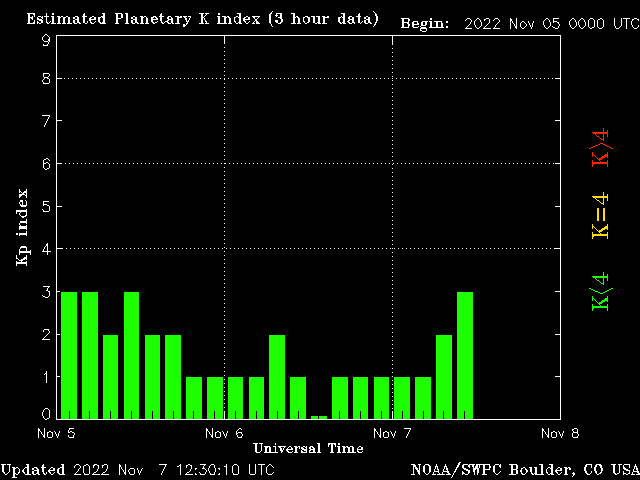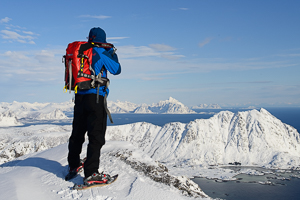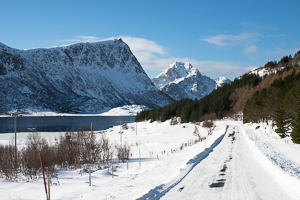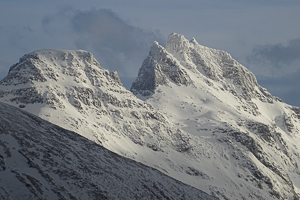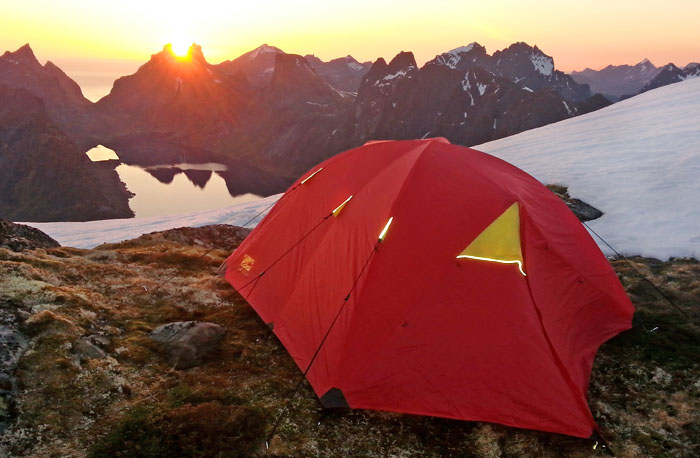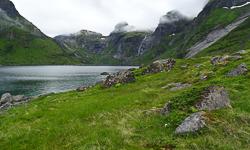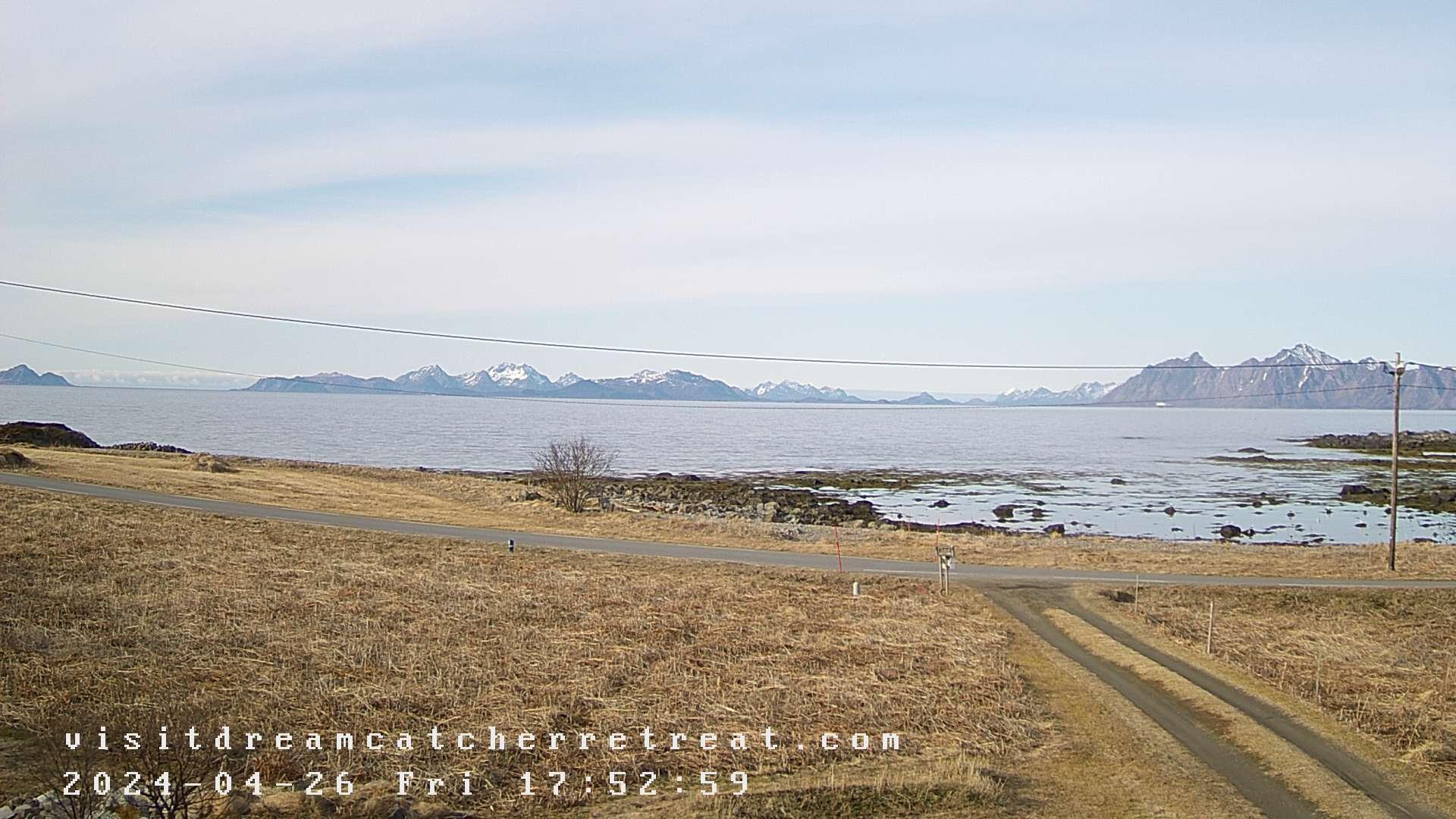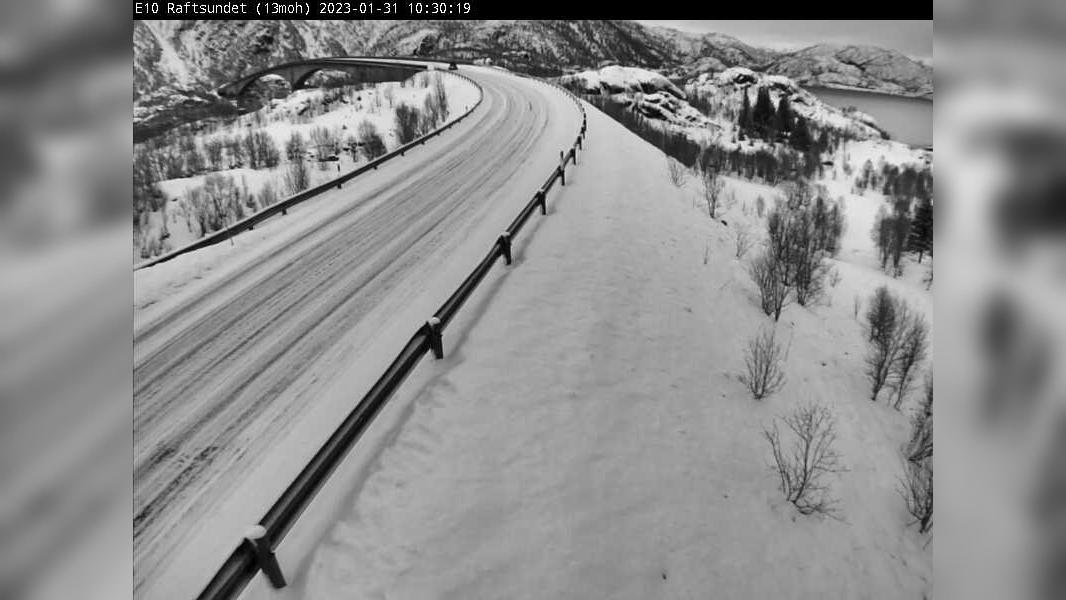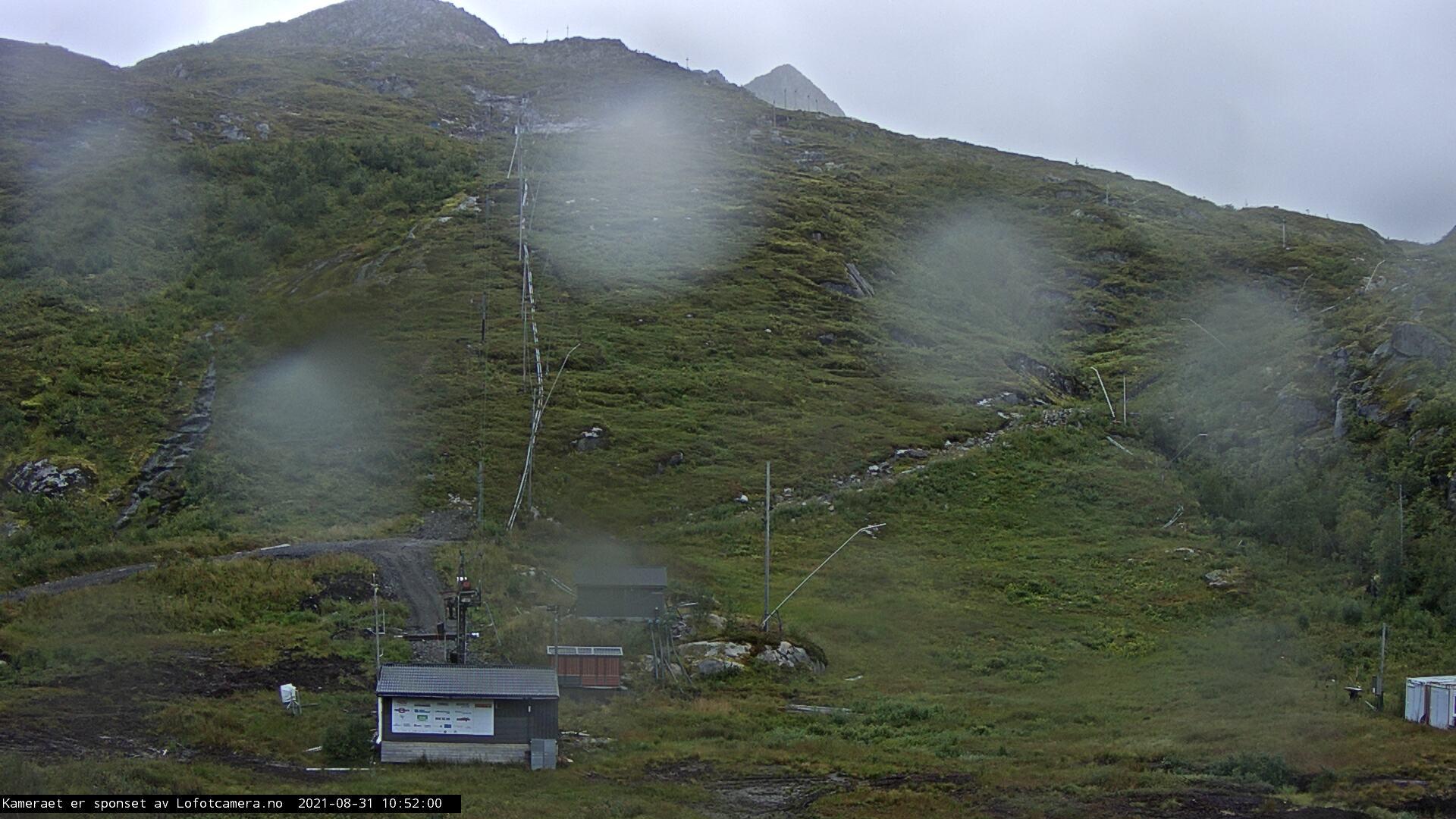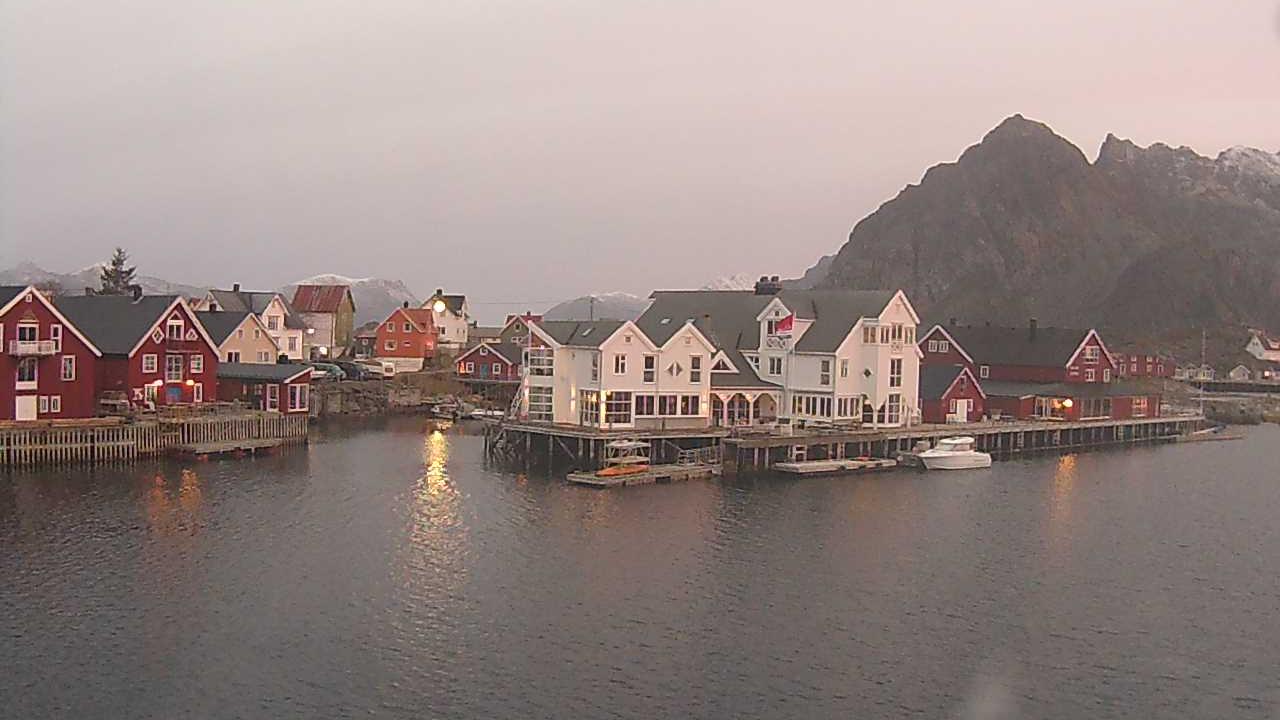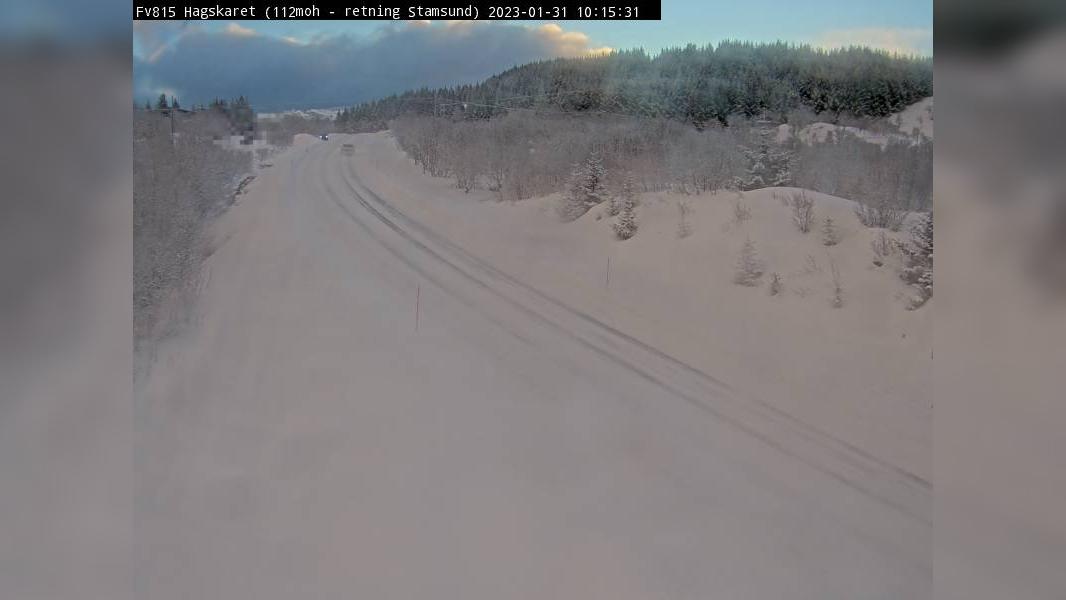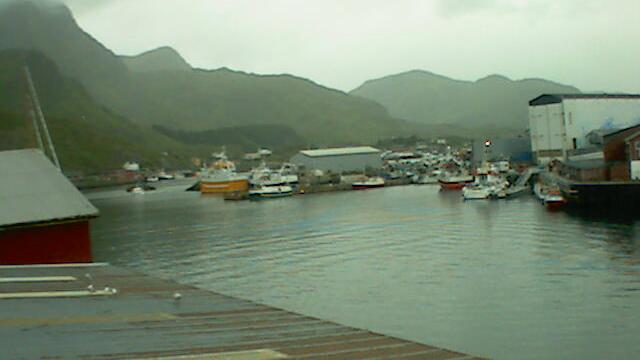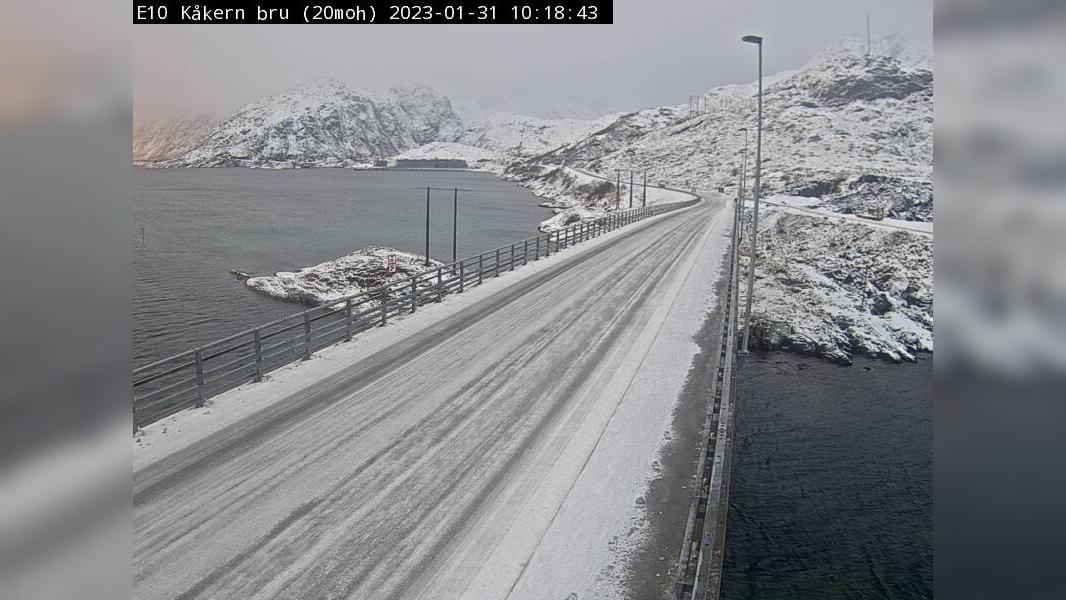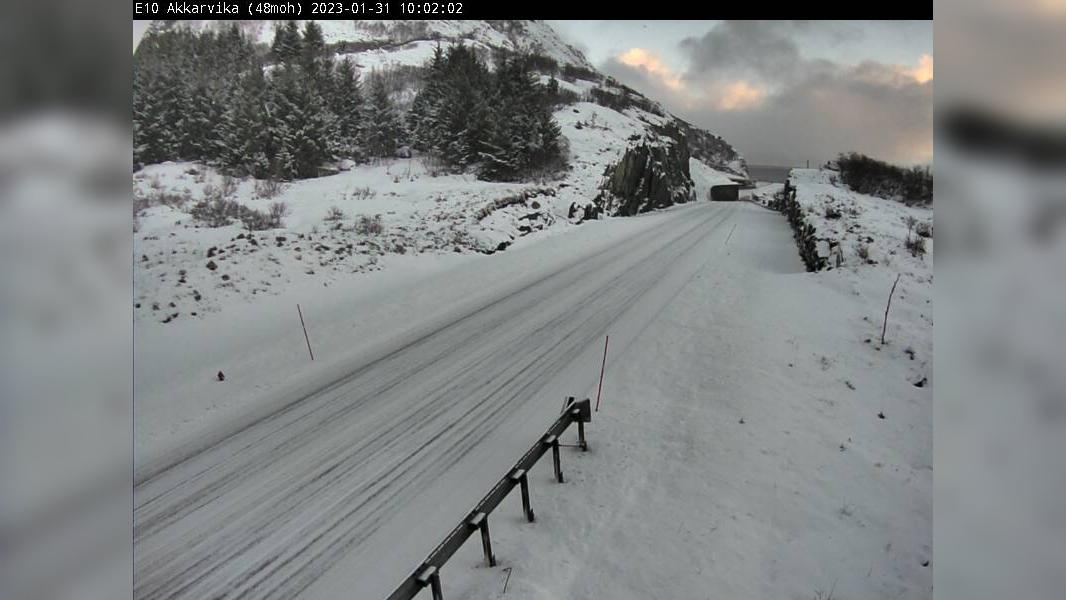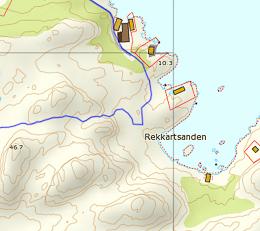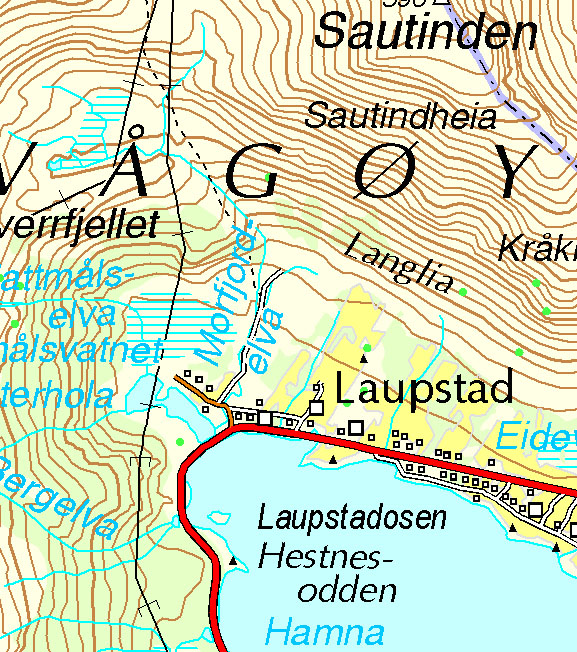And the winer of the contest 2015 is PHOTO n° 17 (Mathieu Savary) !!!
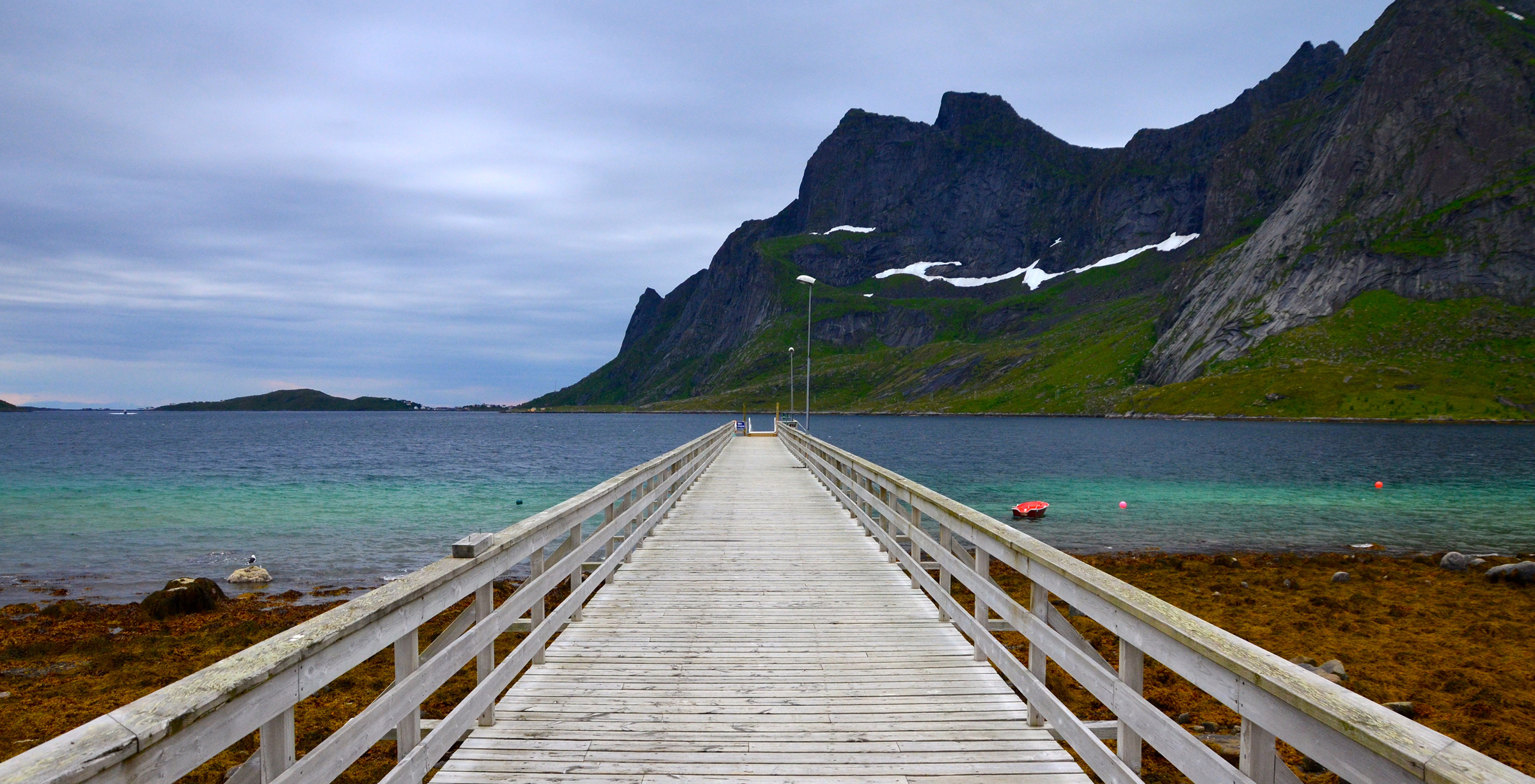
Crossing the Lofoten Islands from North to South
Introduction
My name is Geoffrey, I am 29 and am passionate about the great outdoors. I have been hiking either alone or partly with groups for nearly 10 years now. For several years I have had a yearning to make a crossing on foot alone somewhere where there are mountains. Completely by chance, earlier in the year I came across a gallery of photos of the Lofoten Islands (Facebook page of the Trek (hiking) and/or Terres d’Aventures (Land of Adventures) journal) taken last February/March, I was speechless: it was exactly what I was looking for!
I began to look into it, buying 1/50,000 maps, doing searches on the internet… until I found this great site, completely free: Rando-Lofoten.net. By asking questions on the forum, I received informative, professional answers from David and Magdalena, the site administrators (the Exploranor company) who have lived in the Lofoten Islands six months of each of the last 12 years. I eventually got my plane tickets and booked from 18 July to 2 August 2013. A few more finishing touches and I was finally ready.
The site administrators were quick to reply and their detailed answers were a great help to me in preparing my crossing of the Lofoten Islands. Even though I say “my” crossing, it’s not entirely true. 80% of my trip was based on David and Magdalena’s suggestions, and in the end I only made slight changes. I did, however, find a few areas for improvement which I will suggest shortly (after I’ve checked with the right people that it’s OK!).
The crossing ended in Sorvagen, where the rorbus are located that David and Magdalena run as part of their Exploranor work. I was able to meet them in the flesh, as well as the guides that supervise the groups. I would like to take this opportunity of saying “thank you” and congratulating the entire team with whom I’ve had such a good time!
I promised to provide feedback on my experience of crossing the Lofoten Islands. Both for myself and the site: for myself because it was the occasion to keep a permanent record of this fantastic trip; and for the site because it’s designed to enable people to pool their experience and I was determined to make my information available to everyone. My blog will shortly appear on the Rando-Lofoten site which has kindly offered to host me. This will include an account and detailed report of the crossing, preferred routes and possible alternatives, perhaps a video project (if I can manage it!).
But all that needs a lot of work, and it’s not how I earn my living. Together with David and Magdalena we have decided to give you a little foretaste of my feedback to give you an idea. It’s only an appetizer and I promise that the rest will be on its way shortly.
Here then is an initial description of the route and my immediate overall impressions. (To follow my route on a map, see the map references on the site). Without saying any more before I give a complete account of the crossing, which will be uploaded shortly, I’d like to give anyone considering venturing in the Lofoten Islands a few essential items of information, in no particular order: the characteristics of the terrain and their impact, the unpredictable nature of the trails, vital requirements for such a crossing, a few tips and, of course, a few of the aspects that made the greatest impression on my journey.
I would point out that the trip is organised as follows: arrival in Svolvaer on day 1, the crossing begins the following day and continues until day 10 or 11 (depending on whether you opt for the alternative day 10).
I hope you enjoy my account and, above all, have a good trip!
Description of the route (the hiking guide will be a little more detailed and include maps and routes)
DAY 1
Description: Arrive at Svolvaer at 17h56. The shops close at 11 pm: perfect for buying supplies on site. There are cash machines in the town centre (unusual in the Lofoten Islands).
Bivouac: Sandsletta campsite
Supplies: Preferably in Svolvaer
Logistics: The crossing begins in Delp to the north of Matmora. Ideally you should try to reach the Sandsletta campsite (I hitchhiked). You can then ask Beate (the campsite manager) whether she knows of anyone going to Delp the next morning (she suggested someone when I was there).
Alternative: Sleep in Svolvaer and take the bus to Laukvik from the market place (line 18-733 at least in summer).
DAY 2
Itinerary: From Laukvik go to Delp – Hike up Matmora – Go down to Sandsletta – Bivouac in Haugen if possible, otherwise between Sandsletta and Haugen
Description: Beautiful mountain hike (mountain ridges, summits, lake, forest and fjords). From Delp to the north of Austvagoya climb on the southern face of Matmora (788 metres) to the summit. Then descend via the Rangeldalsvatnet lake. There is then a short section of road before you get to the Sandsletta campsite (not a very busy road).
Bivouac: Sandsletta campsite (allow for 80 to 90 Kr for a tent).
Duration/degree of difficulty: allow 6 hours for this hike (or 7 maximum). No particular obstacles. Approximately 800-metre climb.
Supplies: At the Sandsletta campsite as well as bread, cheese and a little cold meat you can also have breakfast.
Logistics: Nothing to report.
DAY 3
Itinerary: From Sandsletta to Haugen head southwards towards Isvatnet – Possibility of climbing Rundfjellet and descending to Kleppstad via Olderfjord (west facing).
Description: From Sandsletta campsite follow the road for approximately 800 metres, then take the track towards Augen on the right until you reach the trail leading to the Rundfjellet mountain range. Reach the lakes of Itsvatnet and Botnvatnet where the terrain is very alpine (scree, lakes, rugged granite summits). Then descend, off-piste, by the pass leading to Olderfjord. Descending via the pass is not easy, then you have to climb the entire valley which is an immense peat bog, particularly when it is raining. This section is long and tiring. Prepare to get your feet wet. The end of the hike is more pleasant, if rather long: head westwards along the right-hand shore of the Olderfjord until you find the track then the road to Kleppstad (short section of road to finish). To sum up, it’s a challenging hike with a beautiful mountain section followed by a more uncomfortable wilderness. In bad weather it can be hard to keep your spirits up!
Bivouac: The best I could find on this rainy night was the awning at reception for campervans… I don’t recommend it. But you should be able to pitch your tent near the bridge leading to Gimsoy.
Duration/degree of difficulty: Without doubt the hardest hike of the route. It is long, allow 8 or 9 hours. Even though there is not much of a climb (approximately 600 metres) the terrain is very demanding and exhausting, particularly in damp or rainy weather. Long peat bog crossing to reach Olderfjord so you must like having wet feet. It’s impossible to camp in this valley. The trail disappears at Bostvanet (a third of the way along the route).
Supplies: No.
Logistics: Contrary to what the map says there is no trail in Olderfjord. Depending at the time you arrive you may be able to hitch a lift in the small car park which the trail opens onto (the track begins here).
Alternative: the hike may include climbing Rundfjellet (allow two hours extra). Bear in mind this makes it a very long day!
DAY 4
Itinerary: From Kleppstad, hitchhike to the second bridge (route E10). Then take the 815 road that descends southwards to Vikjorden.
Description: Road stage. This is a connecting stage on a road which is not very busy and which is very short. I believe there is a mountain alternative but I don’t know whether it’s OK.
Bivouac: Around Vikjorden.
Duration/degree of difficulty: Allow 2 hours if you manage to hitch a lift but 4 hours if you have to walk the entire distance.
Supplies: No.
Logistics: It is better to hitchhike across Gimsoy and to get dropped off at the second bridge.
Alternative: at the bridge head westwards across the meadow, even though it is hilly, to the lake of Haugvatnet (if necessary following the power lines) – descend south/south west heading east of Molandstjorna to the pass (MortenSkardet) then take up the trail again to the summit (Varden) – Go back down to Moland then Vikjorden.
DAY 5
Itinerary: Leaving Vikjorden, take the trail that climbs to Lyngedalsvatnet then walk to Urdtjorna (small lake) – descend west/south-west (going south of Urdtjorna) then climb Dalstuva – go back down the summit via the trail on the ridge then reach the radio transmitter where the descent to Brustranda begins.
Description: A magnificent mountain hike. You feel alone in the world. There is not always a trail, but the terrain can be walked on and poses no particular obstacles (other than damp in bad weather). Fabulous views over the Haveren mountain range and foothills of Austavagoya, many small lakes…
Bivouac: Brustranda campsite (allow for 100 to 110 kr).
Duration/degree of difficulty: approximately 800 metres climb. Even so, you should allow 7 hours. No particular obstacles, the direction is fairly clear.
Supplies: No, but breakfast is possible at the Brustranda campsite.
Logistics: Nothing to report.
Alternative: Climb Trollsdalstinden, which seems feasible without taking any risks.
DAY 6
Itinerary: From Burstranda, follow the trail that heads west north west until it meets another trail (Gjestberg) – take the trail that heads south west – climb Kartstaven – take the trail to Krenggarsvatnet – when you are about to drop below approximately 200 m altitude, head west towards Leknes via the meadow to reach a trail that goes straight to the town centre.
Description: This is the “summit” stage of the crossing! You can do one summit after the other if you are fit enough. These are beautiful granite mountains covered with heather. This hike offers outstanding panoramic views of three islands (Moskenes, Vestvagoya, Austvagoya).
Bivouac: Around Leknes.
Duration/degree of difficulty: 7 hours without Justadtinden, at least 10 hours including the summit.
Supplies: Yes, in Leknes (the town is a huge shopping mall anyway).
Logistics: quite a long stretch of hitchhiking to look forward to between Leknes and Napp, in other words from Vestvagoya to Moskenes. Pedestrians are not allowed in the tunnel anyway. There are also buses, it may be worth finding out.
Alternative: It is possible to include climbing Blatinden, and why not Justadtinden for hardened walkers (add at least 3 to 4 hours…). What’s more, depending on the weather and season, it’s possible to sleep under the stars on one of the summits you climb in the day (the view from Karstaven is great!) and to enjoy the Midnight Sun! If you want to stick to the schedule, the hike for the next day is a bit long…
DAY 7
Itinerary: From Napp, follow the trail southwards along the coast to Nusfjord.
Description: A magnificent coastal trail that offers a wide range of views. It’s one of my favourite hikes. You pass from one type of terrain into the next: dwarf birch forests, cottages, hollows, fjords, mirror-like lakes, peat bogs and sometimes swamps (at least that’s how it can seem!), granite plateaus and majestic mountain landscapes, before you reach a picturesque fishing village (which is still, nevertheless, a rip-off tourist site)…
Bivouac: Around Nusfjord.
Duration/degree of difficulty: allow for 8 hours as you will sometimes lose sight of the trail. If you get stuck trying to find your way on the map you can head west across the plateau, you will easily find a path to walk on. And the view from up there is staggering! The route climbs only a few hundred metres at most. Even though the end of the hike may feel safer on the road there is nevertheless a trail that climbs slightly.
Supplies: Yes, it’s possible, but I strongly advise against it. The prices are exorbitant, it’s terrible. A tourist rip-off joint if ever there was one.
Logistics: Just so that you know, there is a charge for entering Nusfjord … I think there may be a way of avoiding the entrance where you have to pay, but I haven’t checked it out (I got to Nusfjord at 3 in the morning and didn’t pay anything because the checkout was closed!).
Alternative: No need for an alternative on this hike!
DAY 8
Itinerary: From Nusfjord head south west on the trail along the coast – in Nesland pick up the road and make your way to Ramberg (6 km of road)
Description: A very nice small coastal trail, but which is very busy, beautiful views over the coast and sea, with a “southern” feel to it! Then it’s a track from Nesland, but the environment is spectacular. You finish on a section of road the very end of which is on the E10… But there is no other way (unless you hitchhike).
Bivouac: Ramberg campsite.
Duration/degree of difficulty:
Supplies: Ramberg (supermarket).
Logistics: If you sleep over in Ramberg, you will have to hitchhike back to Fredvang (this section of the E10 is terrible…). There may be buses, it’s worth finding out.
Alternative: It is possible to camp in or around Fredvang because Ramberg campsite is not great (you will need supplies though). It’s nice to hitchhike back to Fredvang to sleep once you have done your shopping!
DAY 9
Itinerary: From Fredvang, cross the meadow to meet up with the trail – climb the pass on the trail then go down to Kvalvika beach. Go to the other side of the beach and climb the pass on the trail, walk the length of Agvatnet lake and follow the trail until you reach the track at Marka. Follow the road to Selfjordhytta. After the small forest on the shore of Selfjord you will find a shelter where you can sleep.
Description: an impressive, varied hike: the golden sand beaches of Kvalvika and its turquoise lagoons, Vestfjord and the surrounding mountains, dwarf birch forests and mountain lakes, a little peat bog nevertheless… a very rich hike!
Bivouac: On the shore of Selfjord, in a shelter near the pontoon.
Duration/degree of difficulty: 5 or 6 hours, taking your time.
Supplies: No.
Logistics: Nothing to report. Ah, yes: there are chemical toilets alongside the shelter and an area where you can build a fire. And a fjord for fishing!
Alternative: No need for an alternative for this hike!
DAY 10
Itinerary: From Selfjordhytta take the trail to Kjerkforden – take the boat to Reine
Description: Another very beautiful hike: you begin by going around the fjord through the dwarf birch forest on a trail that requires a certain amount of skill. Then you climb the first narrow stretch to a lovely mountain lake before beginning to climb the pass that leads towards the golden sand beach of Horseidvika. Once on the ridge it is possible climb several small peaks that offer breath-taking panoramic views over the jagged landscape or the island of Moskenes. Take the really nice trail on the hillside to the second pass leading to Horseidvika. The approach to the beach is magnificent. The hike ends in a small pass that leads to the village of Kjerkfjord from where you take the boat to Reine.
Bivouac: On the outskirts of Reine, Sorvagen… otherwise see the alternative below.
Duration/degree of difficulty: 6 hours approximately, comfortably.
Supplies: No supplies in Kjerkfjord. Otherwise supplies possible in Reine and Sorvagen.
Logistics: Don’t miss the boat to Kjerkfjord! Find out the times and try to get there early.
Alternative: On the boat to Reine you can ask to be dropped off in Tennes and then walk to the power station (at the end of forsfjorden), if the boat can’t drop you there. From the power station follow the water outflow (south/south-west) until you meet the trail – take the trail towards Hermannsdalstinden. Pitch your tent on the foothills of the summit.
DAY 11 (if alternative day 10)
Itinerary: From the bivouac climb Hermannsdalstinden, weather permitting (without a rucksack) – climb back down to the bivouac and pack up – take the trail again to Munkabu – climb Munken – climb back down to Sorvagen
Bivouac: In Sorvagen.
Duration/degree of difficulty: I estimate a minimum 8 or 9 hours walking for this hike. Big climb ahead (around 1000 or 1200 metres uphill).
Supplies: In Sorvagen.
Logistics: Nothing to report!
The whole show!
- Hiking in mountains with your house on your back: muscle and strong nerves…
A solo crossing in these latitudes almost immediately means a very heavy rucksack. In theory there is no such thing as bad weather, only bad equipment. With weather that changes as quickly as it does here you need suitable equipment. And everything is carried by one person: camp stove, tent, food, first-aid kit, etc. In these conditions you really have to allow for the weight of the rucksack in order to gauge your hikes. And I find this itinerary really suited to carrying such equipment: apart from the odd exception, the stages are neither too long nor too demanding and there are relatively few real uphill climbs. The weight of the rucksack should, however, be taken into consideration.
- A demanding terrain that requires a certain concentration
The terrain of the Lofoten Islands is not impossible. On the other hand, it is demanding and sometimes requires a great deal of concentration, particularly if you are hiking alone (the weight of your rucksack may have something to do with this). The terrain alternates between peat bogs, trails through the undergrowth, tracks that run across ridges, steep slopes to climb and wide open spaces. The difficulty may result simultaneously from:
- Ground that gives virtually no grip (the layer of humus is very thin), particularly in the mountains,
- Rocks that become real ice-skating rinks when it rains (they are covered with moss, lichen and/or algae),
- Holes (literally) that can sometimes be surprising in the ground, behind a rock, a root, etc.,
- The effort required in order to jump from one patch of grass to the next when crossing peat bogs, and the understanding of how to read the land that is required!
- The slippery, dangerous roots found throughout trails through the undergrowth,
- Scree which, not content with being real ice-skating rinks as they are, give no grip and move a lot, and where it is therefore possible to lose your footing.
The demanding terrain of the Lofoten Islands therefore requires considerable concentration. You always have to watch where you are stepping and cannot therefore always enjoy the landscape when walking. On the other hand, it’s a terrain which, due to the fact that it requires certain skill, becomes extremely rewarding when you get used to it!
- Those mischievous “troll trails”
In the Lofoten Islands, like elsewhere in Norway and in most Scandinavian countries, I have found that legends around trolls and other mountains elves are still alive in popular tradition. It is said, for example, that trolls appear in the distance and then disappear to tease walkers. I myself have not seen any trolls and so have not been a victim of their pranks!
On the other hand, in fifteen days I have been surprised by the trails which do not seem to hesitate at appearing and then disappearing when they feel like it! It’s not unusual to be on a trail which becomes a small path, then nothing for several kilometres until you come across another trail.
A considerable part of the crossing is therefore off-piste. You therefore need a good sense of direction and be capable of understanding the terrain, which can be read fairly easily: most of the paths you need to take are clear.
- Wet feet: the inevitable sponge effect!
I might as well warn you immediately: given the type of terrain and the unpredictable nature of the trails you must enjoy walking with wet feet, take bad luck in your stride and/or hope for fine weather! The Lofoten Islands are like a giant sponge. It’s therefore a good idea to take a spare pair of shoes if you want to stay dry. But it’s all much easier if you avoid the peat bogs…
- Pleasures of the road:
Given the layout of the Lofoten Islands certain stretches of road cannot be avoided, particularly at the end of a hike and you just have to put up with it.
The advantage of the end of hikes – other than those, like when you get to Ramberg, that are on the horrible E10 – is that they are restful: you don’t have to watch where you are walking and so can enjoy the view. It’s perhaps also the time to listen to a little music, it covers the traffic noise.
I also recommend you take another pair of shoes, such as trainers or running shoes, as well as walking boots for extra comfort.
- If you enjoy fresh food (and are the fisher-gather type)
If you know how to fish, in the Lofoten Islands you are sure of eating fresh fish every evening! I have to say, much to my regret, that I didn’t know how to.
In the right season you also find a lot of mushrooms. I’m not an expert but I think that if you know even a little about the different varieties such as ceps and chanterelles you can also cook them every evening!
Again during the summer there are a lot of berries to be found all over the mountains, particularly my favourites: Arctic berries (also called “peat bog brambles”). If you want to eat fresh fruit you just have to crouch down a little.
To sum up, the Lofoten Islands are an ideal place for fisher-gatherers! All you need is a pack of freeze-dried pasta, a small tub of cream and salt and pepper!
- Hitchhiking in Norway…
Norwegians don’t go in for hitchhiking, at least they are not very keen on it. Only half of the people who stopped to pick me up during my crossing were Norwegian. It’s particularly frustrating given that most of them are on their own in huge cars! You must therefore expect to have to wait. Buses, in certain situations, may be a good option (between Leknes and Napp for example).
- Let’s get down to business: how much does the crossing cost?
By stretching my holiday budget as far as it would go, I managed to find a flight for € 550 and the whole stay cost € 850 for the 9–day crossing, including the return bus trip. With that I was still able to include a pizza in Leknes and fish and chips in Nusfjord (both meals were washed down with a refreshing beer)!
- Relationship with time or the advantages of constant daylight
If, like me, you do the crossing in summer you can take advantage of the constant daylight. And that presents considerable advantages: it’s never night (you never get caught in the dark), and there are no huge drops in temperature when the sun sets (only a little dew, for example, if you decide to sleep under the stars in dry weather). If you get lost in the mountains in fog, for example (which happened to me), there’s no need to panic; if the worst comes to the worst you get back a bit later than planned. So on the whole it’s much better.
And it also enables you to adjust your timing exactly to what you want to do. The only real constraint is managing the travelling time so that you don’t miss the opening times of the shops where you buy your supplies. Or to arrive on time for the boat to Kjerkfjord. Other than these few time constraints constant daylight means total freedom!
And incredible atmospheres. I completed a few hikes quite late (between 1 am and 3 am), and saw the most fantastic light… It seems to me that when you are in the Lofoten Islands, if you organise your day as though you had to stick to French daylight hours you will not take full advantage of the Arctic latitudes.
To end this point, crossing in summer offers a relationship with time and the countryside that is so expanded… It’s really fantastic because you are never in a hurry. Even though this type of holiday may require a certain effort, you nevertheless get back to the real value of time! And that’s worth a lot…
- Unspoilt nature that is accessible and in which there are relatively few dangers
In northern Norway there are bears, lynx, mosquitos (fifteen or so different species, each more ferocious than the last), midges, black flies, … without mentioning the temperatures that can plummet on the continent, even in summer.
In the Lofoten Islands the impact of the Gulf Stream ensures higher temperatures (which doesn’t mean you shouldn’t be equipped because it can drop from 15-18° to 5-8° in less than an hour when the wind get up and the sky gets cloudy and/or it begins to rain…). And you don’t come across any bears, lynx or mosquitos (or very few), midges, black flies or other insects that sting… In other words, in the Lofoten Islands nature is unspoilt but not hostile. Unspoilt, very accommodating nature. Unspoilt nature waiting to be discovered by the curious. Unspoilt nature without danger. Who could ask for more?
When it boils down to it, you just have to enjoy having wet feet.
- Three weeks before you leave, pray to the Sun God for nice weather
Of the 9 days of my crossing, I had unbroken sunshine for 6 consecutive days and only 2 days of really bad weather (rain, wind, fog, cold).
It’s true that the good weather made the crossing a lot easier. The same route in the rain, cold and damp for nine days would have made it much less pleasant.
But, unless you are unlucky, it doesn’t rain continuously in the Lofoten Islands, far from it. The end of May and the month of June are, however, the best periods to travel.
- Bivouac ? Is that what you said?
Throughout the crossing I slept in three different campsites, I was lucky enough to find two makeshift shelters for the two most difficult nights and I slept under the stars for three nights (the weather conditions were suitable). I did not therefore have any problems.
On the other hand, I’m writing this short paragraph just to warn you: it is not always easy to find a good spot to pitch your tent. The peat bogs, forests and hilly terrain don’t help. And if you find flat, grassy areas they are often private property.
So don’t be surprised if you have to search for a while before you find the perfect spot!
- More general impressions (I will try to sum up!)
If I were to try to sum up, firstly I would say that the crossing route is perfectly feasible in terms of physical effort and is very well organised (even though you can improve it to suit you). The two main difficulties are carrying your rucksack, and identifying map references and the nature of the terrain.
Even though the landscapes are not that varied if you consider the route as a whole, they are nevertheless on a large scale and can offer a wide variety of conditions in a single day: you can go from a peat bog to a mountain lake surrounded by a dwarf birch forest before reaching a more alpine setting when you climb to more mountainous altitudes, followed by a beautiful golden sand beach around a turquoise lagoon… all of that before reaching the shores of a fjord that reflects all the surrounding summits!
Another aspect that struck me is the relationship with time. In the summer it’s different and I found it particularly calming. And even though you always come across a sign of civilisation at some point in the day, you still feel immersed in nature which is genuinely unspoilt, and yet not hostile.
The crossing is great and provides fantastic mountain experiences to those who venture on the trip. I personally had 10 days of real joy. I found what I was looking for and I can say that I really made the most of it! In terms of budget, it’s also a cheaper way of exploring Norway …
One final detail: there are a lot of road stages on this route, even though they are generally short. This is as a result of the landscapes of the Lofoten Islands and I believe that certain sections cannot be avoided. Other than the main road (the notorious E10) however, there is not usually much traffic. It would seem a pity not to do this magnificent crossing for this reason. But with a little music and a pair of suitable shoes for walking on asphalt I even found that the end of the hikes were restful (because the terrain is far less demanding!).
I can’t recommend this crossing of the Lofoten Islands highly enough: it’s a joy. And for those who are scared of feeling lonely, you nevertheless meet people, whether hitchhiking, on the trails, in campsites… even though you are on your own most of the time.
To conclude, I highly recommend this crossing of the Lofoten Islands. With all due respect to the trolls and elves… it’s magical.
Geoffroy
Hiking in the Lofoten islands with friends
and fantastic weather – summer 2014
Presentation
To begin, we’d like to thank the site which enabled us to play at being tour operators, on our own!!!!!
3 couples from Haute-Savoie in France, keen hikers....wanting a change of scenery....so we all left on 30 May!
The trip is a bit long. By plane from Geneva to Copenhagen, then Copenhagen-Oslo, Oslo-Bodø, rent a large car, spend the night in Bodø (a town without charm built following the bombings and, on that particular day, cold and rainy).
The following afternoon, ferry from Bodø to Moskenes (we had pre-booked on the internet, it wasn’t the high season yet and those that hadn’t booked had no trouble). After driving an hour and a quarter we reached Gravdal on Saturday night and the lovely house we’d rented (completely red of course with grass on the roof and trolls on the shelf!!!!)
We’re off!!! And, another stroke of luck, fantastic weather all week (in our suitcases we had woolly hats, fleeces, thermal jackets...completely useless...we needed shorts and sunhats...in fact you have to be prepared for anything here).
It wasn’t yet the high season, so we had the scenery all to ourselves!
Photos and text by Laurence Jacquot
Day by day
Sunday, we begin hike 18 quite relaxed in the direction Nusfjord-Nesland (it was early in the seaon and so entry into Nusfjord was still free of charge). Nusfjord is a typical, charming village, the hike not too difficult but not too disorienting either.
Monday hike 7 Munkan....extraordinary... one discovery after another...lakes at every level, the sea always present in the background, the summit (which we managed to reach easily despite the remaining snow) is really great, alpine landscapes (at only 775m altitude with the sea below).
Monday hike 7 Munkan....extraordinary... one discovery after another...lakes at every level, the sea always present in the background, the summit (which we managed to reach easily despite the remaining snow) is really great, alpine landscapes (at only 775m altitude with the sea below).
Read more: Hiking in the Lofoten islands with friends - summer 2014
Lofoten Long Crossing
from South to North - fall 2022
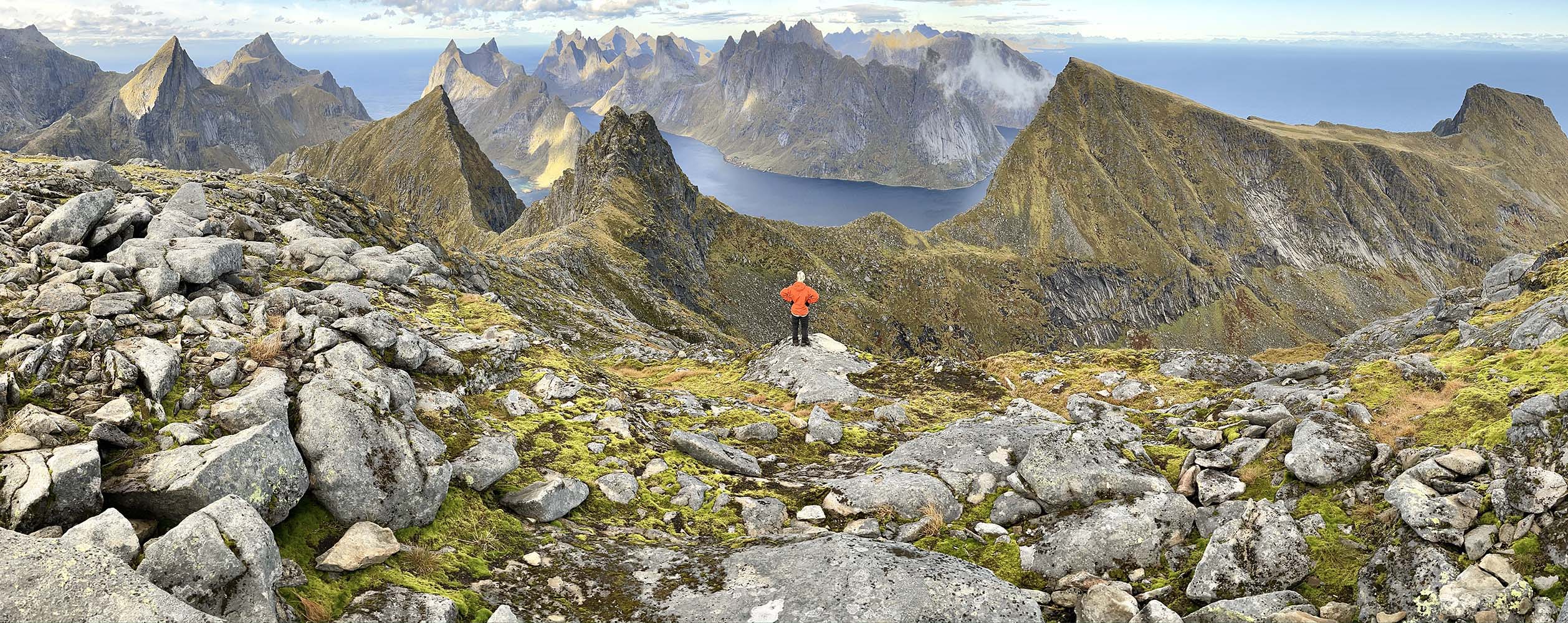
Presentation
My partner and I recently hiked the Lofoton Long Crossing and we made the following notes that covers the entire trip in detail. Please take a read if you are planning your own trip. We hiked in the shoulder season starting September the 24th (2022) and finished 12 days later. We had 2 shorter days due to transportation/logistics and took five amazing side trips.
Photos and text by Vanessa Knibbs & Alex Hierl
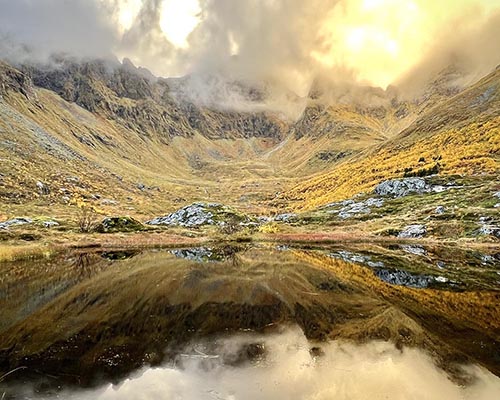 Day by day
Day by day
Day 1, on the 24th we left our vehicle in Napp and caught the first bus of the day at 8:30 am to the southern most starting point at A-Lofoten. It took us 7 days hiking from the South to North to get back to Napp and we did not resupply at any of the shops/cafes. Our first day of hiking was Stage 11 and we found it difficult walking - the path would twist and turn and go through boggy ground and up and over rocky outcrops next to the beautiful Agvatnet. The path up and over to the waterfall at Stokkvikvatnet was very steep and slow going but we were thankful not to be carrying our heavy packs at that point. We loved the views and enjoyed the stage thoroughly despite the difficult walking. We only saw one other person all day. At the end of the day we decided to camp at a small shelter half way along the northern shores of lake Agvatnet. It was not marked on the topo map, it had a sign for Moskesnes fishing club. Our tent fit nicely on the wooden platform and it was dry and sheltered from the high winds. Other possible camping spots would have been closer to the road near the end of the stage, but we found the ground there pretty waterlogged.
Day 2, Stage 10 was long but beautiful, it started off with 2.5 km of road which we tried and failed to hitch a ride along. The upward slog to the Menkebu hut (closed) was eased with amazing views. At this stage the wind was ramping up and we struggled to find shelter behind the hut for lunch/coffee. We were glad we decided to do the recommended side trip up to Munken Nordtopp the views were phenomenal. That night we found a semi-sheltered camp on the veranda at the closed private Kookbura hut on the edge of the Kronkvatnet. The gale force winds swirled all night long and unfortunately it took off with a pair of waterproof socks and underpants: gutted. With weather like that the huge side-trip up to Hermannsdalstinden was out for us.
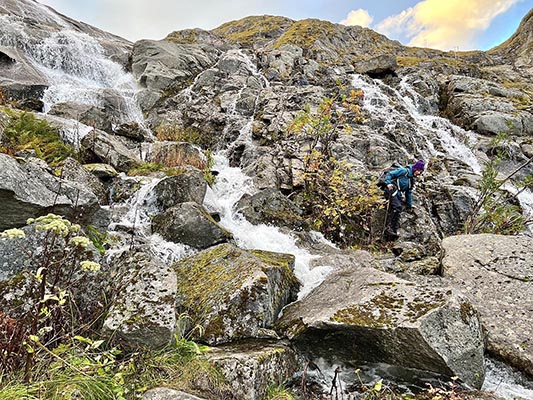 Day 3, Stage 9 commenced with a steep decent to the waterfall off the north western edge of Tennesvatnet. Water spayed everywhere with fierce winds. The most obvious path down led us to cross the waterfall and due to wet and windy conditions it looked dangerous so we decided to turn back to find an alternative (marked on our map). In dryer conditions it might have been the better option. The alternative was the hydro-power pipe-line. This was steep and slippery but manageable. Some red trail markers led us down this was but the wooden makeshift ladder someone had made long ago was all broken up. The decent required a bit of scrambling and passing over our heavy bags. Getting to the fjord edge we found a heap of large mussels at low tide and so rewarded ourselves with a big steamy breakfast. The description on the website had said it would take 45 min to get down, it took us almost twice that time. The 3.5 km walk along the edge of Forsfjorden was extremely slow going to start with but improved closer to Vindstad.
Day 3, Stage 9 commenced with a steep decent to the waterfall off the north western edge of Tennesvatnet. Water spayed everywhere with fierce winds. The most obvious path down led us to cross the waterfall and due to wet and windy conditions it looked dangerous so we decided to turn back to find an alternative (marked on our map). In dryer conditions it might have been the better option. The alternative was the hydro-power pipe-line. This was steep and slippery but manageable. Some red trail markers led us down this was but the wooden makeshift ladder someone had made long ago was all broken up. The decent required a bit of scrambling and passing over our heavy bags. Getting to the fjord edge we found a heap of large mussels at low tide and so rewarded ourselves with a big steamy breakfast. The description on the website had said it would take 45 min to get down, it took us almost twice that time. The 3.5 km walk along the edge of Forsfjorden was extremely slow going to start with but improved closer to Vindstad.
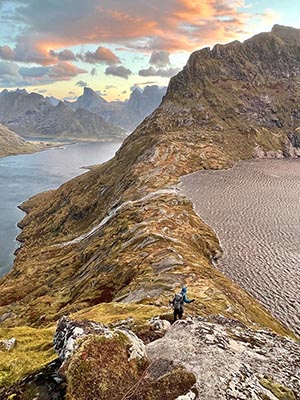 The ferry connection did not work for us. The next ferry that day meant waiting 2.5 hours and then only getting to Reine and waiting there til the next day to get the ferry to Kjerjfjorden. So we continued along from Vindstad walking up Bunesfjorden and over to the beach views of Buneset. This meant we had to hike up and over the pass at Helvetestinden, the views were amazing totally worth it. We attempted to get up to the summit however the gale force winds almost blew us off out feet and we decided to continue down into the valley to find camp before the light faded. Luckily the decent was sheltered from the highest winds. There was a very rough foot pad leading us down but we saw no cairns. The ground was slippery in places and very very steep, but we were able to zigzag down avoiding the dangerous rocky slabs. We have done a heap of this type of hiking before and we felt pretty comfortable slowly picking our was down the steepest sections with the aid of walking poles. If it had been raining/much wetter ground I think it might have been impassable. After searching for about half and hour we found some shelter for our tent behind a huge set of boulders about 500m from the village at Kjerkford. The majestic mountains and high cliffs here were so humbling.
The ferry connection did not work for us. The next ferry that day meant waiting 2.5 hours and then only getting to Reine and waiting there til the next day to get the ferry to Kjerjfjorden. So we continued along from Vindstad walking up Bunesfjorden and over to the beach views of Buneset. This meant we had to hike up and over the pass at Helvetestinden, the views were amazing totally worth it. We attempted to get up to the summit however the gale force winds almost blew us off out feet and we decided to continue down into the valley to find camp before the light faded. Luckily the decent was sheltered from the highest winds. There was a very rough foot pad leading us down but we saw no cairns. The ground was slippery in places and very very steep, but we were able to zigzag down avoiding the dangerous rocky slabs. We have done a heap of this type of hiking before and we felt pretty comfortable slowly picking our was down the steepest sections with the aid of walking poles. If it had been raining/much wetter ground I think it might have been impassable. After searching for about half and hour we found some shelter for our tent behind a huge set of boulders about 500m from the village at Kjerkford. The majestic mountains and high cliffs here were so humbling.
Day 4, Our fourth day (still Stage 9) took us up the stunning valley to lookout onto Horseid beach (we didn’t want to swim with high winds) and up and over the pass under Krokhammastinden. The walking seemed easier now than stages 11 and 10 apart from a bit of meandering around boulders along Fageravatnet and boggy ground close to Selfjordhytta. Before the main hut there was a lovely camping spot in a stand of pine trees with a wooden platform, fire pit and picnic bench. The nearby toilet hut was unusable though. We didn’t camp there because it was too early in the day and we didn’t have the key for the “DNT” hut. So we continued on the easy dirt road until we hit the trail again at Markvatnet. The lake is used for drinking water so camping near it is prohibited. We did find a wonderful emergency stone-built shelter with 2 wooden platforms that we used to camp in. That night we had the best view of the Aurora and had a dry (warmish) place to camp, it was the perfect size for two people. It was marked on the topo map.
Read more: Lofoten Long Crossing from South to North
It’s very easy to publish your feedback. Here’s how:
1) Create an account with Rando-Lofoten. (This account will also give you access to our hiking guides and allow you to take part in the site forum). If you are not already a member, create your account.
2) But being a member does not entitle you to publish articles on our website, for that we have to list you as an author. To do this, just send us an e-mail and we’ll unlock "Author" mode in your member profile.
3) Then return to the site and use your ID and password to log in.
4) When you are connected, the button "Submit a new article" will appear at the bottom of the page. Click on this button and start writing your article!
5) Once you have submitted your article it will be read by a member of the Rando-Lofoten team and, provided it complies with all our publication criteria, it will be published quickly.
 Jean-Baptiste is a Frenchman from Rouen in Normandy who arrived in Norway four years ago after following his girlfriend to Oslo. Even though the love story ended there, he decided to stay and take the first job he was offered. He graduated from the faculty of sport and after working as a lifeguard in France, he found work in a completely different field. After a trial period of only one week, he was offered a job in a restaurant in Paris. He got on so well that after three months he became the chef. He now works as a cook in another restaurant, Maren Anna in Sørvågen in the south of the Lofoten Islands, where he has learned to cook the traditional dishes of the islands (halibut, whale stew, dried cod, etc.). He now speaks Norwegian and is a keen hiker.
Jean-Baptiste is a Frenchman from Rouen in Normandy who arrived in Norway four years ago after following his girlfriend to Oslo. Even though the love story ended there, he decided to stay and take the first job he was offered. He graduated from the faculty of sport and after working as a lifeguard in France, he found work in a completely different field. After a trial period of only one week, he was offered a job in a restaurant in Paris. He got on so well that after three months he became the chef. He now works as a cook in another restaurant, Maren Anna in Sørvågen in the south of the Lofoten Islands, where he has learned to cook the traditional dishes of the islands (halibut, whale stew, dried cod, etc.). He now speaks Norwegian and is a keen hiker.
Rando-Lofoten: How did you end up here in the Lofoten Islands?
Jean-Baptiste: After working in Oslo for about ten months I was no longer very interested in what I was doing and needed a change of scenery. I thought I could give it a go in the Lofoten Islands which I had already visited ten years earlier on a hiking holiday.
Read more: Jean-Baptiste
United colors of Lofoten !
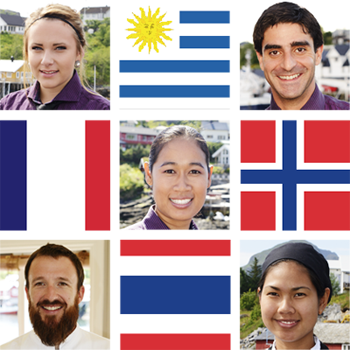
We wanted to know what the Lofoten Islands mean to foreigners living or working on the islands and what their initial impressions were when they first arrived on the archipelago.
We therefore decided to interview people of very diverse origins who work in the one and only restaurant in the small village of Sørvågen, which has around 450 inhabitants, located to the south of the archipelago between A-i –Lofoten and Reine in the Moskenes district.
Jean-Baptiste, a Frenchman, Aphasara from Thailand, Maritt, a Norwegian from the Lofoten Islands and Frederico a Uruguayan, all work at the Maren Anna restaurant and agreed to answer our questions.
 Aphasara is a new recruit at Maren Anna where she works as a cook. She comes from the town of Nakhan Sawan in Thailand where she worked in her mother’s restaurant. She has lived in Sørvågen for three years with her Norwegian husband and two year-old baby and has learnt Norwegian.
Aphasara is a new recruit at Maren Anna where she works as a cook. She comes from the town of Nakhan Sawan in Thailand where she worked in her mother’s restaurant. She has lived in Sørvågen for three years with her Norwegian husband and two year-old baby and has learnt Norwegian.
Rando-Lofoten: What did you feel or think when you first arrived here ?
Aphasara: Before moving here I came on holiday with my husband to Bodø in the north of Norway. It was in June, I woke up in the middle of the night and its was light. I shook my husband, telling him it was time to get up, that we’d slept until midday. He took me out to see the midnight sun (laughter). When I moved to Sørvågen it was very different.
Read more: Aphasara
Maritt is a Norwegian from the Lofoten Islands. She is one of the ten partners who invested together and launched the Maren Anna restaurant in 2011. She is one of the three partners who work in the restaurant with Aneth the Head Chef and Trond who works at the bar.
Rando-Lofoten: You have worked at Maren Anna from the start. How did it all begin?
Maritt: The restaurant opened in July 2003, which means that this year is the eleventh season. Before that I worked for 21 years with the Post Office, firstly in Sørvågen, then Reine, followed by Ramberg on the Island of Flakstad. I moved around as the post offices gradually closed down.
Read more: Maritt
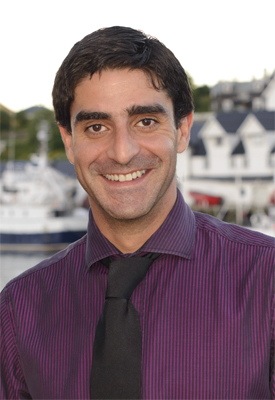 Frederico was born in Uruguay but has lived in Spain for the last twelve years, in Barcelona, Coruna (north-west Spain) and then in Tenerife where he moved to find work in the tourist sector and because of the climate. He worked at a few odd jobs in Spain for a temping company, but he trained for three years as a waiter, which is his real job. He has now been waiting at the Maren Anna restaurant/bar for the second year running.
Frederico was born in Uruguay but has lived in Spain for the last twelve years, in Barcelona, Coruna (north-west Spain) and then in Tenerife where he moved to find work in the tourist sector and because of the climate. He worked at a few odd jobs in Spain for a temping company, but he trained for three years as a waiter, which is his real job. He has now been waiting at the Maren Anna restaurant/bar for the second year running.
Rando-Lofoten: How did you end up here in the Lofoten Islands?
Frederico: In fact, I had never thought of coming to Norway. Sometimes I used to think about leaving Spain, but I thought about Great Britain or Germany where I knew there were good opportunities to find work, but I don’t speak German… The reason I’m here today is that I met Trond, one of the bosses at Maren Anna. He was on holiday with Sarah in Tenerife in October 2011. They saw me working on the evening my workmate failed to turn up for the shift. I had to do the work of two people and must have moved around a bit faster than usual and I think they were impressed.
Read more: Frederico
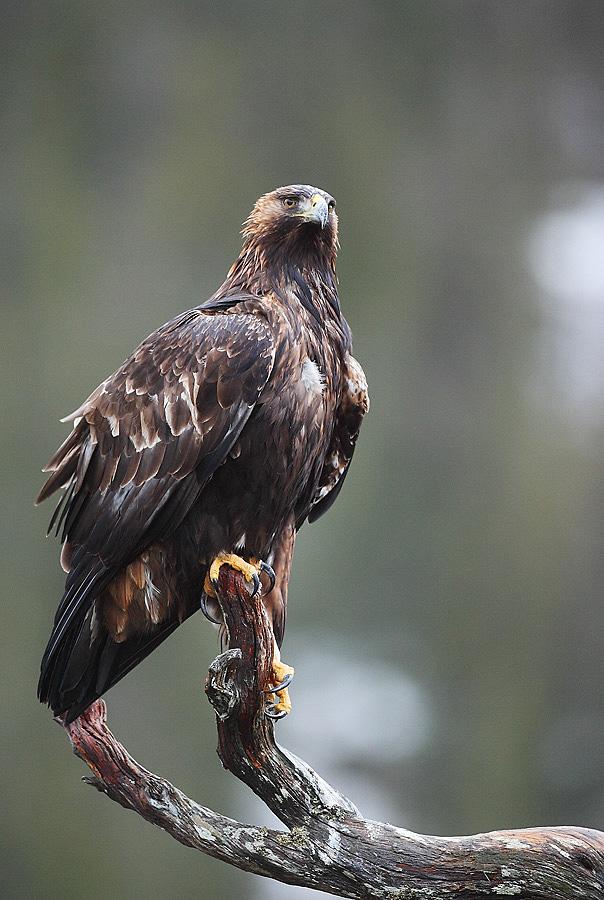 We recently came across an article by the Norwegian Ornithological Federation (NOF) reproduced by the local Lofoten federation (Lofoten Lokallag) and it seemed important to share it with you here.
We recently came across an article by the Norwegian Ornithological Federation (NOF) reproduced by the local Lofoten federation (Lofoten Lokallag) and it seemed important to share it with you here.
According to this article, the Norwegian parliament, under pressure from the lobby of sheep farmers and reindeer herders, is about to authorize hunting the golden eagle—a protected species everywhere in Europe and the rest of the world.
Unfortunately, the eagle isn’t the first victim of the sheep farmers’ lobby in this country. Yet Norway is often cited as an example of sound ecological and environmental policy! Over the last few years, the Norwegian parliament has re-introduced the permission to slaughter many protected species such as the wolf, the lynx, the bear and the wolverine. And the list is growing longer without alarming anyone, or almost anyone.
Moreover, Norway isn’t the only country engaged in this environmental regression: France is following close behind, with its recent authorization to slaughter wolves for the same reasons.
Biodiversity has already been seriously threatened by other economic sectors and human expansion in general; this policy endangers it still more.
As citizens, hikers and lovers of the wilderness (what's left of it), we think it’s time to use our most powerful weapon: buying power!
It’s time to make outmoded politicians and the lobbies manipulating them realize that we don’t want to buy the products of sheep-farming or reindeer-herding when it is carried out to the detriment of wild animals and biodiversity.
Read the complete article here (in English)
Conversation with a mountain hiker
It was while we were climbing to the top of Narvtinden that we met Håkon and his girlfriend Kristin. At the pass, before the final steep section we saw two hikers with a small black dog that was briskly climbing the 40°slope. Despite the short distance that separated us we were only able to catch up with them at the top when we immediately began chatting.
Håkon, a 33 year old Norwegian, agreed to answer our questions and to meet us, outside on a small mountain overlooking the plateau of Leknes a stone’s throw from the Gravdal hospital where he works as a radiologist. This is where he comes after work to run or just get a breath of fresh air.
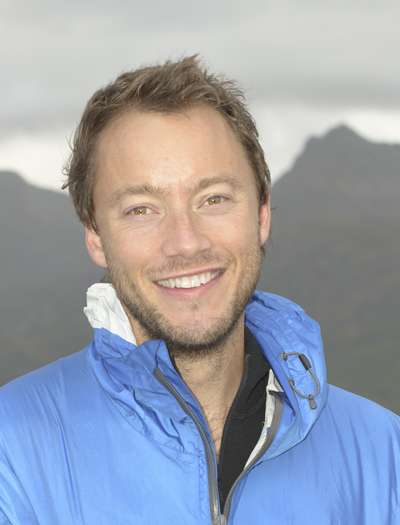 Rando-Lofoten: Do you practice any sports other than hiking?
Rando-Lofoten: Do you practice any sports other than hiking?
Håkon: I use to be a very keen cross-country skier (langrennsløper), but that’s quite a while ago. When I was younger I was eager to take up the sport seriously but I had to stop when I was 17 due to various injuries. First of all I injured my knee and they didn’t know what was wrong at the time. Then, when I started again, I injured my elbow.
Rando-Lofoten: Did you practice cross-country skiing at a high level?
Håkon: Well, when I was 16 I won the north Norway championship in my category (nord norges mesterskap). But I haven’t done much since. I keep training though. I like to train and keep in good shape. I jog in summer and in winter I do endurance training and cross-country skiing, both traditional and skating. In winter I also like to go on long ski hikes pulling a pulk (sledge) from chalet to chalet. I am also slightly unusual in that I enjoy sleeping in a tent in winter. Most people find it too cold but I like it and I am lucky in that I don’t really feel the cold.
I am very lucky with my working hours at the hospital where we work shifts. I often have five or six days off at a time and then I go to the mainland where I have a lot of friends whom I call to see whether they are free to come with me.
Rando-Lofoten: When we met the first time you mentioned a sort of challenge, which is to climb all the peaks on the islands? Could you tell us a little more?
Håkon: It all began in my hometown in the Lyngen Alps where I was already used to walking the peaks. It was part of my growing up. I was two years old when I first went to the mountains and I didn’t want to stay in the baby carrier. I was determined to walk (laughter). So it goes back quite a way. In general I have always been attracted by the mountains, and in different ways. First there is the physical aspect, I like to stay in shape, but it’s also, and above all, nature itself. When I first arrived in the Lofoten Islands five years ago I began walking over the various peaks and I heard of someone who had climbed all the peaks over 100 m altitude in Vestvågøya, the central island of the Lofotens. I thought climbing 100 m peaks was a bit too low. It wasn’t that the challenge had to become an athletic exploit at all costs, but by setting the limit at 100 m altitude you have to climb all the small hills and therefore spend a long time with your head in the map. I thought it was a bit stupid. I had already climbed quite a few peaks in the Lofoten Islands and I thought why not climb the others, so that I could say I’ve done them all. This desire to climb all the peaks comes from the fact that, in general, I like to go to new places. It’s exciting because you never know beforehand what the climb is actually going to be like. What’s it going to be like actually walking there? What you see on the map is one thing, but will I manage to get to the top? Some of them are such steep slopes that when I start out I don’t know whether I will manage to get to the top. And, of course, what’s the view like from up there? Even though you have climbed the neighbouring peak, you don’t know what it will be like on this one.
What motivates me is to find out what it’s like when you are actually there, out of curiosity and of course for the experiences and sensations you have in nature, with animals for example. But it’s true that you can have contact with nature even if you always climb the same peak. You get an extra buzz if you always go to new places, it makes the whole experience a bit more mysterious (laughter)… and it gives you a goal.
Rando-Lofoten: How many peaks have you climbed since you began 5 years ago?
Håkon: On the island of Vestvågøya I have climbed around 140 peaks over 300 m altitude, but it a bit depends on the criteria you use to count them… I haven’t followed strict rules as such. On the whole I have climbed all the peaks that have a name. Then I started on the island of Flakstad where I climbed around 80. I have therefore climbed up to all the peaks on the island. Then I started in Moskenesøya. In the north of the island the only one I haven’t climbed is Ulvstinden (Wolf’s Peak) and the summits of Lillejordtinden. I haven’t been much to the south of the island, but I’m working on it.
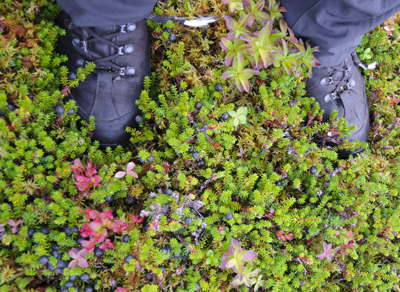 Rando-Lofoten: Now that you have climbed all the peaks in Flakstadøya and Vestvågøya as well as those in Moskenesøya, you have almost achieved your goal. What are you going to do afterwards, have you already got an idea for a new challenge?
Rando-Lofoten: Now that you have climbed all the peaks in Flakstadøya and Vestvågøya as well as those in Moskenesøya, you have almost achieved your goal. What are you going to do afterwards, have you already got an idea for a new challenge?
Håkon: I’ve still got the island of Vågan in the Lofotens to do, but I haven’t yet made up my mind. It’s also because I prefer landscapes with low vegetation, open landscapes. It’s what I find most appealing. Whether for hiking or setting up my tent, I prefer this type of vegetation (he points to the thick cushion-like layer we are sitting on, made up of moss, lichen and small shrubs). In Vågan there are a lot of trees and forest, you almost need to have a saw with you to cut your way through to certain peaks. But I’m not saying I won’t do it.
Rando-Lofoten: And after the Lofoten Islands are you going to continue climbing peaks elsewhere?
Håkon: No, well I don’t really know. I’ll take it as it comes. Even though it’s not become an actual obsession, I am very interested nevertheless. (laughter)
Rando-Lofoten: Did you fit in easily in the Lofoten Islands?
Håkon: I found it very easy. North Norway (Nord Norge) has the reputation of being very welcoming. There is a big difference between the north and south of the country. For example in north Norway, it is possible to pick up a hitchhiker and bring him home, ask him to stay for dinner and suggest he stay a night or two. Such things are not unheard of. Many Norwegians from the south are surprised at the welcome and how easy it is to be asked to stay. In that respect I don’t see any difference between the Lofoten Islands and the place where I was born (Lyngen) which are both in the same region. There are small local differences in Nordland of course. In Bodø, for example, people are more reserved whereas in Tromsø, which is a student town, you can easily speak to anyone in the street.
Rando-Lofoten: To return to nature, is there something special here in the Lofoten Islands compared to where you come from? Many people, both abroad and in Norway, talk and dream of this place.
Håkon: I remember the first time I came to the Lofoten Islands. I took the car and crossed the fjord by ferry because I was living in Bodø at the time. I remember when the boat opened its doors and I saw the Lofoten Islands. You get to the wharf in Moskenes and it seems like the mountains are literally falling on it. What’s strange is that even though the mountains are lower than elsewhere, they are extremely close. There is little vegetation and everything seems very close.
The Lofoten Islands have often been compared to a miniature version of the Lyngen Alps. And for me who grew up in Lyngen, I understand because whether here or in Lyngen, you always have the fjord and the ever-present sea. The main difference is the mountains which are much higher in Lyngen. The highest peak where I come from is 1833 m, and on average they are around 1200 or 1300 m. In the Lofoten Islands the average must be around 600-700 m.
What I love in the Lofoten Islands are all these small places, all these little groups of houses, like in Nusfjord towards Sund, all these little hamlets spread over the archipelago. It’s a little self-contained world, a land of tales in which you don’t feel enclosed because the landscapes are very open.
Rando-Lofoten: Do the Norwegians, particularly the people from the Lofoten Islands, have a special relationship with nature, and if so, why?
Håkon: To answer that we need to go back in time a little, when there were no shops or anything. The people here had to live very close to nature because it’s how they survived, through fishing. It was the main source of food in the Lofoten Islands and you can still see the traces today with the houses on stilts (rorbu). The houses were built on the premise that nothing was more important than fishing. Being close to nature was a vital necessity. There are a lot of stories on the subject according to which the fishermen knew every nook and cranny of the shore like the back of their hand and they only had to spot a small piece of land through the mist to know where they were. They had to be familiar with nature in order to survive and learn a lot of tricks. There is no doubt that there are differences between the people from the Lofoten Islands, who are closer to nature, and people in the big cities, particularly in the past when the town dwellers got their food in other ways.
But nowadays in the Lofoten Islands I am just as likely to meet a tourist as a local when I walk in the mountains. Not many of the locals hike here. In the south of Norway, where there are far more people, there are very popular treks and hikes (Hardangervida, Jotunheimen, etc.) where you meet a lot of people whereas in the north of Norway, whether in the Lyngen Alps or the Lofoten Islands, you are more likely to come across tourists than locals.
Rando-Lofoten: Isn’t the fact that not many locals here go hiking mainly because their lives were entirely focused on fishing and therefore the sea rather than inland?
Håkon: It’s true that there’s not much to hunt here, no large mammals for example. Remains of birds have been found that the people used to hunt, but that’s about all.
If I can tell you a story, it reminds me of when I went hiking close to where I lived on the mainland and I met an old man. It was winter and he said I could park on his land. I then went up into the valley, I went on a long hike, on my own, and when I came back he asked me what the purpose of my walk was… and then told me that he used to go often to the mountains when he was a child but to hunt partridge. He therefore had a reason for going. He couldn’t understand why I went into the countryside on my own for no purpose, as far as he could see. And another time when I was out in the kayak on my own a man came over on a boat to see me and we began talking. He quickly explained that a little further on towards the end of the fjord there was a chalet with people, and that I should not hesitate to go in for a chat. I really had the impression he thought I was lonely. He couldn’t imagine that I could be there on my own and enjoy myself.
Rando-Lofoten: Do the young Norwegians go hiking?
Håkon: There are high hopes for open-air activities. The Norwegian tourist offices have really promoted these activities. There have also been adverts on the TV. The matter has also been discussed at length in the public health debates. Being active, going hiking has become sort of trendy, and it’s getting more so. It has to be said that things have changed a lot in Norway. If we look at my father’s generation, or rather that of my grandfather, they were so worn out by work that at the weekend all they wanted to do was rest. But we now have time to go for a walk and I am aware that in Norway we no longer work as hard or for as long as in other countries. It doesn’t mean that everyone will go for a walk but research has shown that more educated people are generally more attentive to their physical condition and more likely to take exercise.
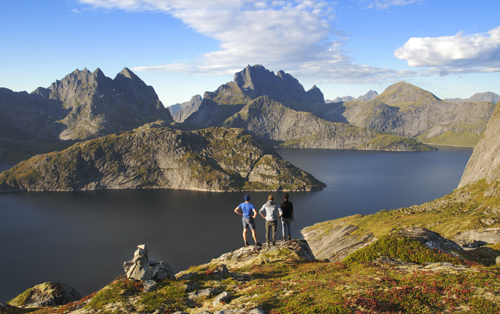 Rando-Lofoten: We’re actually not that far from Lapland, do the Sami people have a different relationships with nature compared to the other Norwegians?
Rando-Lofoten: We’re actually not that far from Lapland, do the Sami people have a different relationships with nature compared to the other Norwegians?
Håkon: I know a few stories about the Sami people. They know the Vida (tundra plateau) really well. It all looks the same to us, one mound is like another. But they are able to find their way without GPS or maps. They have the map here, in their mind. It’s incredible, there may be no visibility but they will eventually find their way. I have a relative who works in Svalbard (Spitzbergen) in charge of rescue and she told me a story on this subject. A group got lost in the countryside and split up, such that a Sami found himself alone. The other part of the group eventually reached Longerbyen, the capital of Spitzbergen, but the Sami was missing. Someone said, jokingly “Don’t worry he’s a Sami, he’ll find his way”. And he did indeed reappear, he had no GPS or any means of determining where he was, no visibility and a strong wind was blowing. When he arrived he was asked how he managed it. He replied jokingly “I sniffed out the route”. They have something we don’t.
My father, who was at school near Alta (a town in Norwegian Lapland), told me he had planned to go fishing with Sami friends. It had been raining heavily for several days. They were going to light a fire and as everything was soaking wet, my father thought it would never take. But, surprising though it may seem, the fire was lit in only a few seconds. And apparently everything had dried out. They knew how to go about it.
Rando-Lofoten: Do many Sami live in the Lofoten Islands?
Håkon: There are some. I have Sami blood. I tell people for a joke that I have the very old genes of the original people (Laughter). In Lyngen the following three branches interbred: Nordmen (Norwegians), Kvens (an ethnic minority in Norway, originally from northern Finland and Sweden who migrated to north Norway in the 18th and 19th centuries) and the Sami. The people mixed. For myself we have to go a bit further up the family tree, but I have, for example, Sami cousins who breed reindeer in Finnmark. The Sami have been oppressed for a long time in Norway. But that’s changed nowadays. In my hometown in Lyngen the signs are in three languages: Sami, Kven and Norwegian, they are all official languages.
Large crows fly overhead, they seem to be having fun with the wind that sweeps across the top of the peak on which we are standing. They are doing synchronised flying in pairs.
Rando-Lofoten: It’s perhaps not very poetic but those birds fly like fighter planes!
Håkon: Yes, they train while playing. They are one of the few birds that can fly upside down.
I have had incredible encounters with birds, particularly eagles. Once I must have been near a nesting zone. A dozen eagles began flying round overhead and just as I looked upwards to watch them, I saw one of them open its talons and a small lump of earth fell at my feet. It was a warning, even though I have never heard of any real eagle attacks. I had already had a similar experience when I found myself very close to an eagle’s nest. The parent pretended to dive-bomb me. It stopped nevertheless twenty metres or so above me, it was only pretending to attack, but it’s frightening nevertheless, particularly when it comes at you with its talons open. Another time high up in the mountains, I was looking for another way to get down and I arrived at the edge of a steep cliff. I leant slightly over the edge to see, and approximately half a metre below me there was an eagle sitting on its nest (white-tailed eagles can have a wingspan of up to 2 m 70 and their body is the size of a dog). It turned around and looked at me. I watched it for some time, it didn’t move. I will always remember it. It was only on the way down that I realised I could have taken a photo, but perhaps it wouldn’t have been very good and it wouldn’t have been as good as the image I have kept in my mind.
Interview translated from Norwegian by David and Magdalena, the 5th of septembre 2013
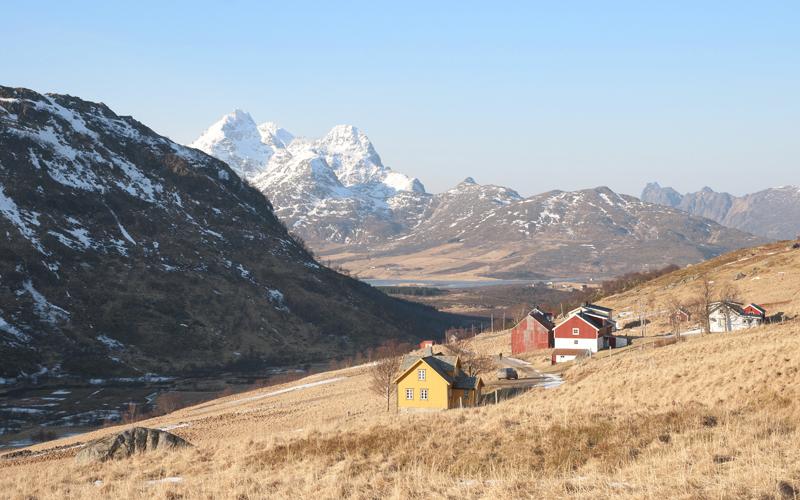
The people of the Lofoten Islands say there has not been such a mild winter for 100 years!
As far as we are concerned we prefer to wait for the statistics to be published by the authoritative “National Meteorological Institute” before we express an opinion, but the following facts cannot, however, be ignored:
- Temperatures of +5 to +6°C in February
- Still no snow, or very little on the peaks
- A spring-like feel to the air (buds, catkins, birds building their nests, etc.)
We have put our snow shoes away and taken out our hiking shoes to explore the Lofoten Islands in temperatures and countryside similar to those of the month of May! Using small crampons to help us climb the mountain tops, we are making the most of the unusually mild temperatures to do in winter what we usually do throughout the summer: explore, draw up and publish new hiking routes on Rando-Lofoten.
Here are a few photos to give you an idea of winter in the Lofoten Islands and some of our new hikes…
Watching opportunities
Excellent
| Good | Medium | None* |
| March | February | January | May |
| October | Beginig of April | November | June |
| | September | December | July |
| | | | August |
*Impossible to watch at Northern light due to constant daylight
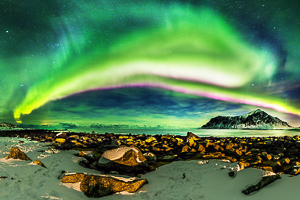 The National Oceanic and Atmospheric Administration (NOAA) has implemented a real-time northern light prediction map for each hemisphere.
The National Oceanic and Atmospheric Administration (NOAA) has implemented a real-time northern light prediction map for each hemisphere.
This map gives a forecast, for the next 30 to 40 minutes, showing the size of the aurora and the places in the world where it can be observed. The probability as well as the intensity of the light is represented by a gradient of colors (going from green to red).
Note: In order to observe the northern lights, it is essential that the sky is cloudfree. Therefore it is important to cross the data below with the one of the local weather forcast.
Here you'll find the last update of the map.

For more information you can visit the site directly from NOAA at the following address: http://www.swpc.noaa.gov/products/30-minute-aurora-forecast
3 days Aurora forcast
What’s the Kp-index?
The Kp-index is the global geomagnetic storm index. It ranges from 0 to 9, where a value of 0 means that there is very little geomagnetic activity and a value of 9 means extreme geomagnetic storming. Depending on your geomagnetic latitude (were you are), and on the Kp value, you will know if there is any chance for you to see an aurora.
How does the Kp-index work?
The table below shows you until which latitude you will be able to observe the Auroral Oval, depending on the Kp strength.
| Kp | Geomagnetic latitude | Auroral activity |
| Kp 0 | 66,5° or higher | Very low |
| Kp 1 | 64,5° | Low |
| Kp 2 | 62,5° | Low |
| Kp 3 | 60,4° | Unsettled |
| Kp 4 | 58,3° | Active |
| Kp 5 | 56,3° | Minor Storm |
| Kp 6 | 54,2° | Moderate storm |
| Kp 7 | 52,2° | Strong storm |
| Kp 8 | 50,1° | Severe storm |
| Kp 9 | 48,1° or less | Extreme storm |
Example: With a Kp 0; you can observe an aurora in Tromso in Norway, with a Kp 5; you can see the aurora all the way to Edinburg in Scotland, and with a Kp9 (the maximum that is possible), you can view an aurora all the way to Marseille in France.
Prevision for the next 3 days
Note: This list, gives some interesting/practical links (in alphabetical order) in relation with the observation and the understanding of the aurora phenomena. This list is not exhaustive, and you are very welcome to suggest new links through our contact form.
www.norway-lights.com
This website gives a 3 days-prevision in any town of Norway. Direct link to the Lofoten.
www.spaceweatherlive.com
You will find updated solar activity previsions, as well as auroral activity previsions, with clear explanations to understand the data. Multilingual website.
www.gi.alaska.edu/AuroraForecast/Europ/
The official website of Alaska Fairbanks University, gives a 21 days forecast for auroral activity in both hemispheres, as well as some practical information.
NOAA - National Oceanic and Atmospheric Administration
The prestigious American agency provides most of “space forecasts” data used by the worldwide scientific community.
Smartphone apps’:
Northern Eye : is a free app' that allows you to follow the aurora forecasts for the 3 next days (with information on the Kp, Bz, the solar windspeed, etc).
I am Martin and I have spend over 2 months in Lofoten in 2017 to capture photos of northern lights - one of the best shows you can see on the sky.
You can see the results here on my website: www.martin.kulhavy.info
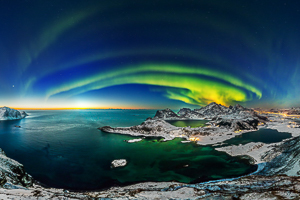
Tips and tricks:
1) equipment
Astrophotography is demanding high performance from your camera and lens. You will get best results with interchangeable lens cameras (mirrorless or single-lens reflex camera). Use wide and bright (low aperture number) lenses. There are several lenses specialized for astrophotography which could be also useful for "normal" landscape photography. I use Samyang 14mm f/2.4. My other recommendation would be Samyang 14mm f/2.8, IRIX 15mm f/2.4 or an expensive Sigma 14mm f/1.8. Spare battery, tripod and cable release is also necessary.
2) Check the weather and space forecast
Clear sky is essential for your success, so save your energy in cloudy days to be ready for clear nights. Check the short term forecast on yr.no. Detailed view will give you indication for the cloud level. Spaceweather.com or Aurora mobile app helps with forecasting of solar and aurora activity. Lofoten is north enough for observing lights even at low KP indexes (2 or 3). Higher KP index is obviously better, but it doesn't guarantee anything.
3) Location
Find your location in advance. Look for places with good view to the north. There is no general rule for this point. You can find one many hikes on this website (www.hiking-lofoten.net). I recommend to stick with your plan in the evening, You don't want to spent the precious time while driving between locations. Be patient, sometimes lights appear for only a brief moment after few hours of waiting. Keep walking around your tripod in winter to stay warm.
4) Shooting tricks
Shoot on Manual settings. My general settings are ISO 3200, f/2.4, t=3s and then I adjust time shutter speed accordingly to the situation. If the lights are weak, then I go to t=8s, stronger light can reduce the time to 1s. Please note that you must recalculate the shutter speed if your minimal aperture number is higher. Example: if your minimal aperture number is f/3.5, then your times should be between 2 and 15 seconds. You can reduce then to 1-8 seconds by increasing ISO to 6400, but your images will be noisier. The brightness changes rapidly and it is important to change your shutter speed immediately to get rightly exposed photos.
Shoot panoramas. Even 14mm wide lens is often not wide enough for aurora oval. All my photos are full 360 panoramas. There are many websites describing details of 360 photography. Fell free to contact me if you have any questions.
Martin Kulhavy
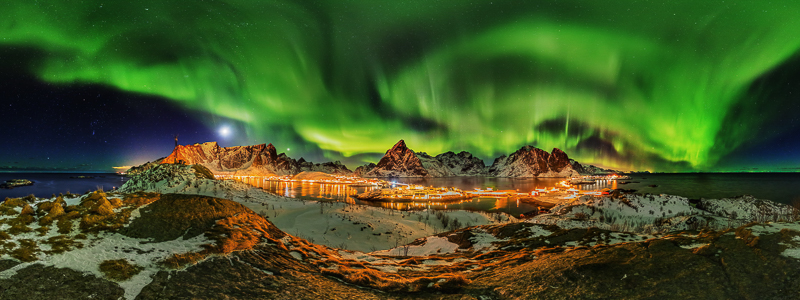

 Photo 1 Photo 1
Photo 1 Photo 1  Photo 2 Photo 2
Photo 2 Photo 2  Photo 3 Photo 3
Photo 3 Photo 3  Photo 4 Photo 4
Photo 4 Photo 4  Photo 5 Photo 5
Photo 5 Photo 5  Photo 6 Photo 6
Photo 6 Photo 6  Photo 7 Photo 7
Photo 7 Photo 7  Photo 8 Photo 8
Photo 8 Photo 8  Photo 9 Photo 9
Photo 9 Photo 9  Photo 10 Photo 10
Photo 10 Photo 10  Photo 11 Photo 11
Photo 11 Photo 11  Photo 12 Photo 12
Photo 12 Photo 12  Photo 13 Photo 13
Photo 13 Photo 13  Photo 14 Photo 14
Photo 14 Photo 14  Photo 15 Photo 15
Photo 15 Photo 15  Photo 16 Photo 16
Photo 16 Photo 16  Photo 17 Photo 17
Photo 17 Photo 17  Photo 18 Photo 18
Photo 18 Photo 18  Photo 19 Photo 19
Photo 19 Photo 19  Photo 20 Photo 20
Photo 20 Photo 20  Photo 21 Photo 21
Photo 21 Photo 21  Photo 22 Photo 22
Photo 22 Photo 22  Photo 23 Photo 23
Photo 23 Photo 23  Photo 24 Photo 24
Photo 24 Photo 24 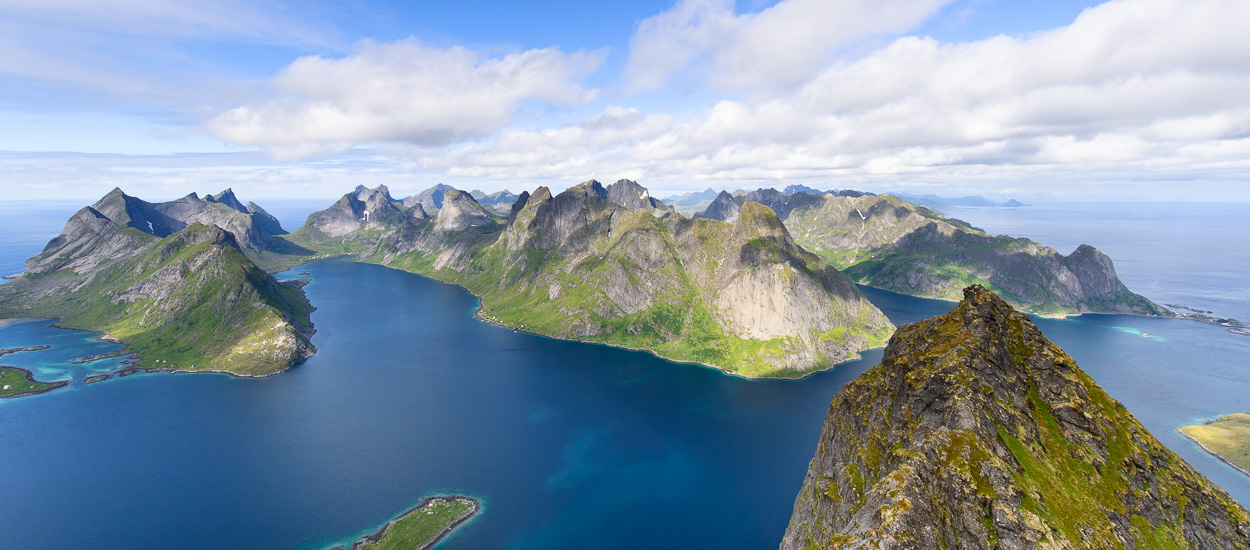




 Day by day
Day by day Day 3
Day 3 The ferry connection did not work for us. The next ferry that day meant waiting 2.5 hours and then only getting to Reine and waiting there til the next day to get the ferry to Kjerjfjorden. So we continued along from Vindstad walking up Bunesfjorden and over to the beach views of Buneset. This meant we had to hike up and over the pass at Helvetestinden, the views were amazing totally worth it. We attempted to get up to the summit however the gale force winds almost blew us off out feet and we decided to continue down into the valley to find camp before the light faded. Luckily the decent was sheltered from the highest winds. There was a very rough foot pad leading us down but we saw no cairns. The ground was slippery in places and very very steep, but we were able to zigzag down avoiding the dangerous rocky slabs. We have done a heap of this type of hiking before and we felt pretty comfortable slowly picking our was down the steepest sections with the aid of walking poles. If it had been raining/much wetter ground I think it might have been impassable. After searching for about half and hour we found some shelter for our tent behind a huge set of boulders about 500m from the village at Kjerkford. The majestic mountains and high cliffs here were so humbling.
The ferry connection did not work for us. The next ferry that day meant waiting 2.5 hours and then only getting to Reine and waiting there til the next day to get the ferry to Kjerjfjorden. So we continued along from Vindstad walking up Bunesfjorden and over to the beach views of Buneset. This meant we had to hike up and over the pass at Helvetestinden, the views were amazing totally worth it. We attempted to get up to the summit however the gale force winds almost blew us off out feet and we decided to continue down into the valley to find camp before the light faded. Luckily the decent was sheltered from the highest winds. There was a very rough foot pad leading us down but we saw no cairns. The ground was slippery in places and very very steep, but we were able to zigzag down avoiding the dangerous rocky slabs. We have done a heap of this type of hiking before and we felt pretty comfortable slowly picking our was down the steepest sections with the aid of walking poles. If it had been raining/much wetter ground I think it might have been impassable. After searching for about half and hour we found some shelter for our tent behind a huge set of boulders about 500m from the village at Kjerkford. The majestic mountains and high cliffs here were so humbling. Jean-Baptiste is a Frenchman from Rouen in Normandy who arrived in Norway four years ago after following his girlfriend to Oslo. Even though the love story ended there, he decided to stay and take the first job he was offered. He graduated from the faculty of sport and after working as a lifeguard in France, he found work in a completely different field. After a trial period of only one week, he was offered a job in a restaurant in Paris. He got on so well that after three months he became the chef. He now works as a cook in another restaurant, Maren Anna in Sørvågen in the south of the Lofoten Islands, where he has learned to cook the traditional dishes of the islands (halibut, whale stew, dried cod, etc.). He now speaks Norwegian and is a keen hiker.
Jean-Baptiste is a Frenchman from Rouen in Normandy who arrived in Norway four years ago after following his girlfriend to Oslo. Even though the love story ended there, he decided to stay and take the first job he was offered. He graduated from the faculty of sport and after working as a lifeguard in France, he found work in a completely different field. After a trial period of only one week, he was offered a job in a restaurant in Paris. He got on so well that after three months he became the chef. He now works as a cook in another restaurant, Maren Anna in Sørvågen in the south of the Lofoten Islands, where he has learned to cook the traditional dishes of the islands (halibut, whale stew, dried cod, etc.). He now speaks Norwegian and is a keen hiker.
 Aphasara is a new recruit at Maren Anna where she works as a cook. She comes from the town of Nakhan Sawan in Thailand where she worked in her mother’s restaurant. She has lived in Sørvågen for three years with her Norwegian husband and two year-old baby and has learnt Norwegian.
Aphasara is a new recruit at Maren Anna where she works as a cook. She comes from the town of Nakhan Sawan in Thailand where she worked in her mother’s restaurant. She has lived in Sørvågen for three years with her Norwegian husband and two year-old baby and has learnt Norwegian. Frederico was born in Uruguay but has lived in Spain for the last twelve years, in Barcelona, Coruna (north-west Spain) and then in Tenerife where he moved to find work in the tourist sector and because of the climate. He worked at a few odd jobs in Spain for a temping company, but he trained for three years as a waiter, which is his real job. He has now been waiting at the Maren Anna restaurant/bar for the second year running.
Frederico was born in Uruguay but has lived in Spain for the last twelve years, in Barcelona, Coruna (north-west Spain) and then in Tenerife where he moved to find work in the tourist sector and because of the climate. He worked at a few odd jobs in Spain for a temping company, but he trained for three years as a waiter, which is his real job. He has now been waiting at the Maren Anna restaurant/bar for the second year running. We recently came across an article by the Norwegian Ornithological Federation (NOF) reproduced by the local Lofoten federation (Lofoten Lokallag) and it seemed important to share it with you here.
We recently came across an article by the Norwegian Ornithological Federation (NOF) reproduced by the local Lofoten federation (Lofoten Lokallag) and it seemed important to share it with you here. Rando-Lofoten: Do you practice any sports other than hiking?
Rando-Lofoten: Do you practice any sports other than hiking?  Rando-Lofoten: Now that you have climbed all the peaks in Flakstadøya and Vestvågøya as well as those in Moskenesøya, you have almost achieved your goal. What are you going to do afterwards, have you already got an idea for a new challenge?
Rando-Lofoten: Now that you have climbed all the peaks in Flakstadøya and Vestvågøya as well as those in Moskenesøya, you have almost achieved your goal. What are you going to do afterwards, have you already got an idea for a new challenge?

 The National Oceanic and Atmospheric Administration (NOAA) has implemented a real-time northern light prediction map for each hemisphere.
The National Oceanic and Atmospheric Administration (NOAA) has implemented a real-time northern light prediction map for each hemisphere.
